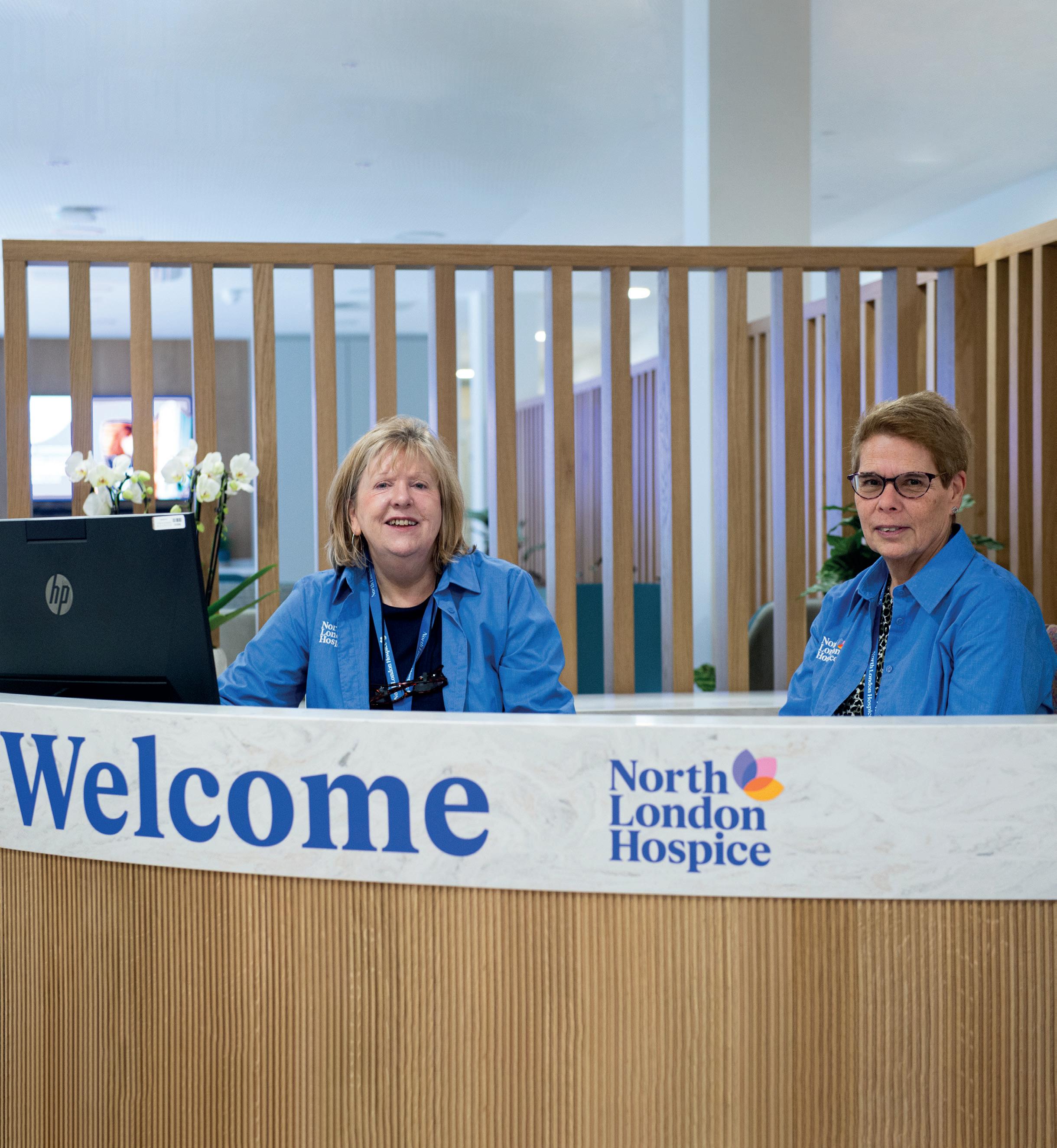

Contents
Message from Chair and Chief Executive
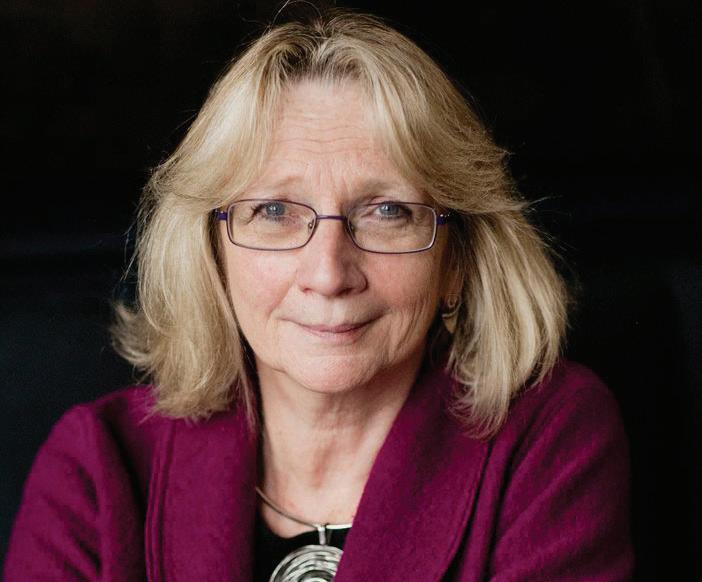
“The best of life at the end of life, for everyone”
All that we do at North London Hospice is driven by the spirit behind these words – our vision.
We’d like to start by saying a huge and heartfelt thank you. Whether you’re a supporter, member of staff, a volunteer, or a partner, we simply couldn’t have had such a positive year without you.
In 2022-23 we were still in a period of recovery from the Covid-19 pandemic which posed significant challenges for us and affected every aspect of the hospice’s operations. From our priority of keeping our patients, staff, and volunteers safe, to our income generation, every single aspect of how the hospice is run and operated has continued to be reviewed and carefully monitored by our Executive Team, Committee Governance and Board of Trustees.
It was another year of extraordinary challenges for end-of-life care and our services at North London Hospice. But your support helped us build, develop, and grow in key areas to meet the needs of our community and work towards achieving our vision. As an organisation we have continued to be dedicated, creative, innovative, and responsive. Despite the operational pressures, we have remained focused on continuing to deliver quality improvements to patient care to our communities in Barnet, Enfield, and Haringey.
Whilst much of our attention through the year has been focused inwards, there have also been some important, long-awaited developments in service provision, most notable of which has been the commissioning of the five borough North Central
Declan Carroll Chief Executive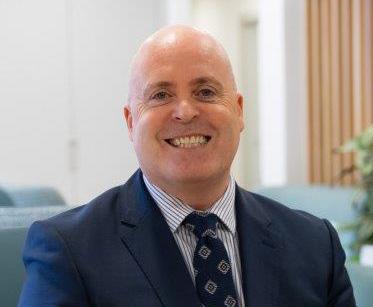
London – Palliative Advice Team (Single Point of Access service), with North London Hospice appointed as the lead provider.
This has been the culmination of many years of work by the team, and it is a very positive development for the provision of hospice care across the five boroughs of Barnet, Enfield, Haringey, Camden, and Islington – opening opportunities for us to work in two new boroughs.
Our new brand and visual identity, launched in September 2022, won Gold at the London Design Awards and has received an overwhelmingly positive reaction from supporters and stakeholders. We are looking forward to being bolder and more ambitious with our design work and our new brand guidelines and visual identity will allow us to do this and will help us to raise our profile.
Rising energy costs, increases in the cost of living and the impact of events on the international stage will inevitably affect our communities, our staff, and volunteers and on the capacity of North London Hospice to continue to provide the wide range of services that we currently support.
We are confident that our key strategic relationship with the North Central London Integrated Care Board will continue to contribute positively to the wider discussion of specialist palliative care in North London as Integrated Care Systems emerge.
Every day, we all have the pleasure to work alongside the best staff and volunteers who help to make our charity the special place it has become within the communities of Barnet, Enfield, and Haringey. We can’t put a value on what our
services mean to all the patients, families, and friends that we have cared for and supported over the years and will continue to support for years to come, but we can talk with pride, as we hope you all do, about how important our work is at North London Hospice.
What we provide at North London Hospice is priceless to the people we help because it is about quality of life at a point at which life itself becomes limited and each moment, each day becomes precious. The best of life at the end of life has become our clearly defined vision – and reminds us every day of the principle that we are a person-centred organisation not just for 250 staff and 600+ volunteers, but also for the patients, their families and friends and the wider community.
Thank you for reading – we hope you find this report helpful and informative.
Lis Burgess Jones Chair Board of Trustees Declan Carroll Chief ExecutiveOur year in numbers
Outpatients and
1476 1074 94%
4796

788,018

million
items sold in our shops, supporting our commitment for recycling and our green pledge





Our Strategy and Ambitions 2021-25
Our Vision
The best of life, at the end of life, for everyone
Our Purpose
North London Hospice - working together to provide palliative care and support, when and where you need us most
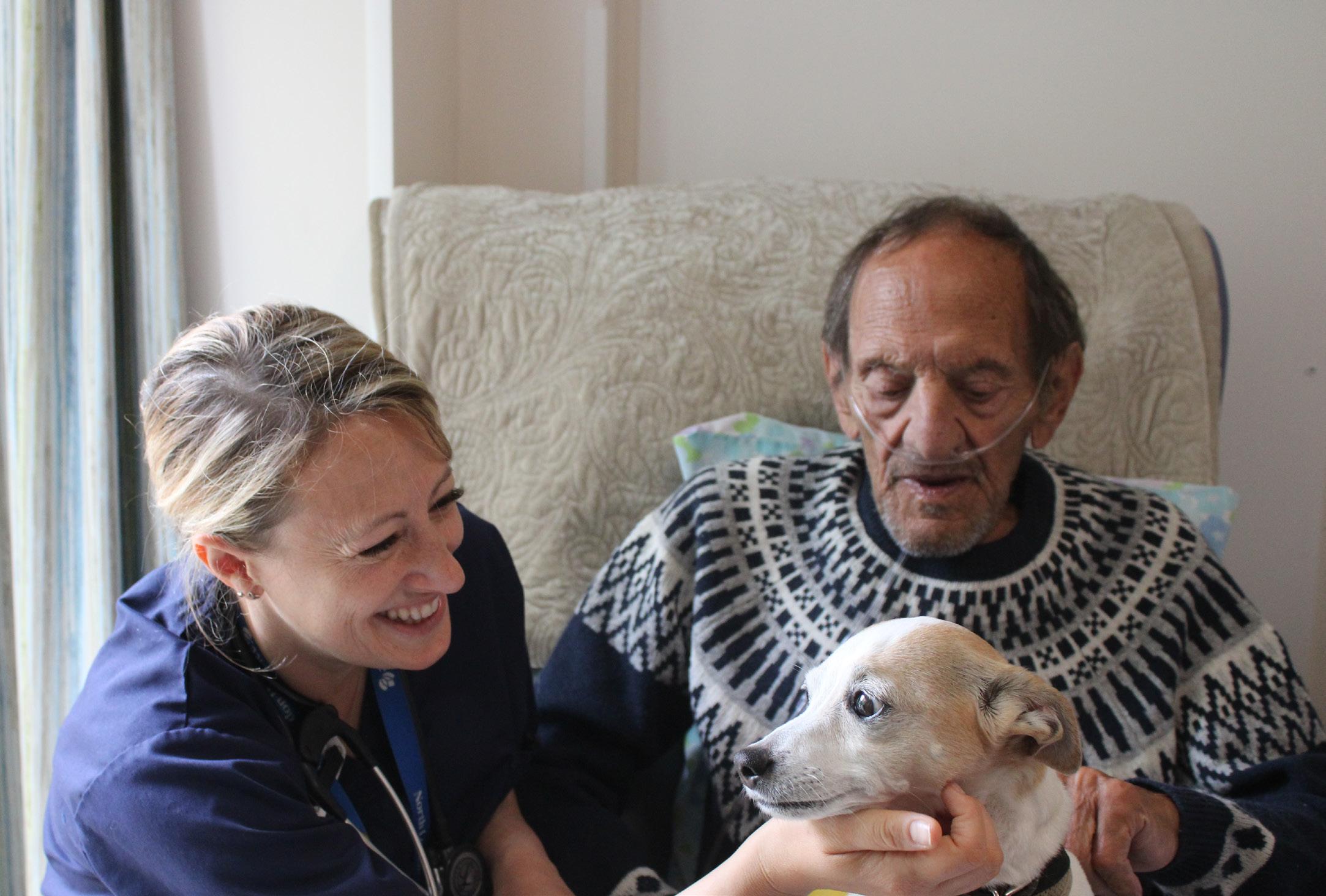
Our Values
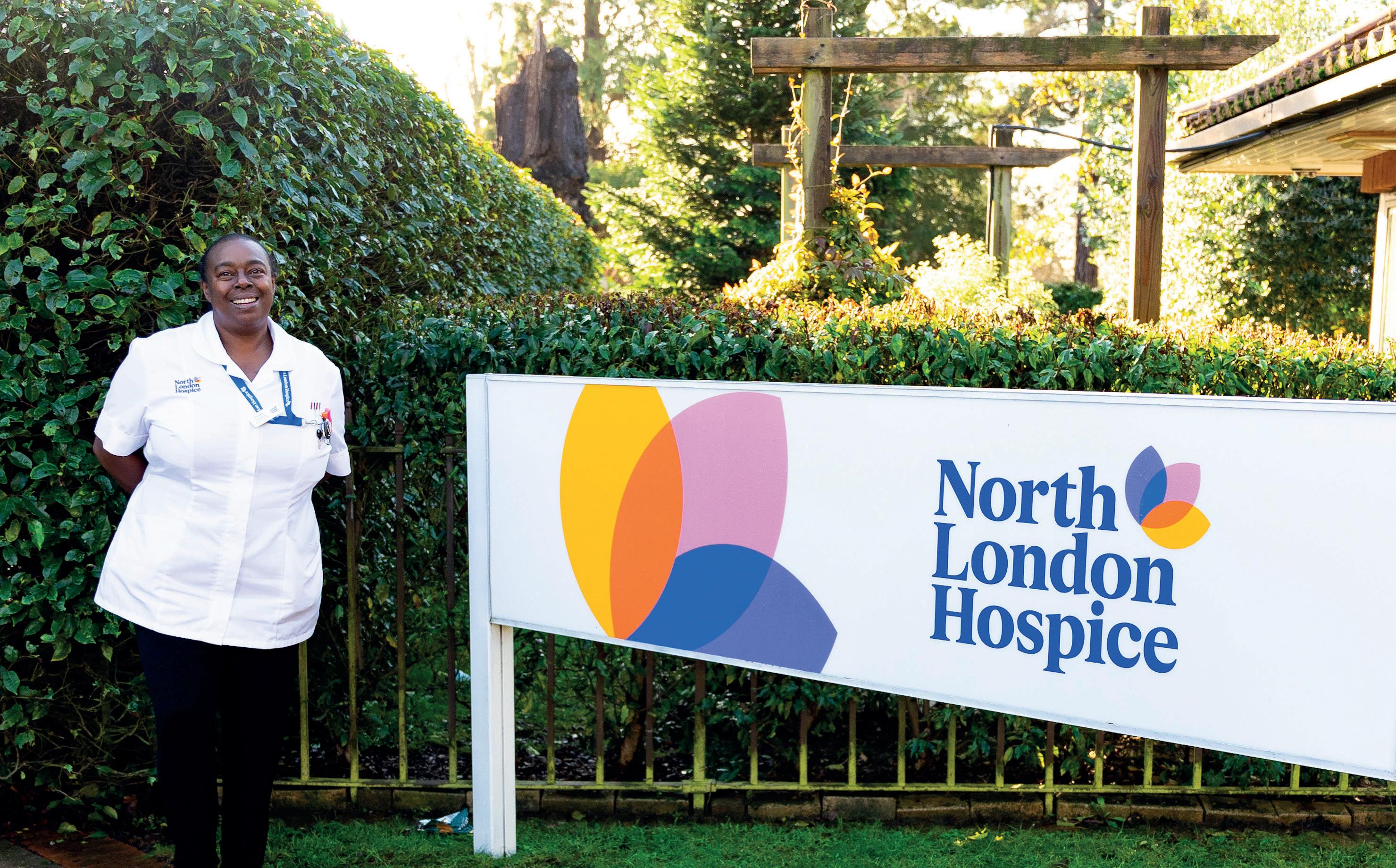
C O R E
Collaborative and learning
Open and honest
Respectful and empowering
Contents
Our key Strategic Ambitions within our Strategic Plan (2021/25) are the driver for success and enable us to provide the best of life, at the end of life, for everyone, in the communities we support across the London boroughs of Barnet, Enfield, and Haringey.
AMBITION 1 – Our Reach
We will drive innovation and deliver quality through everything we do
We will ensure outstanding care and support is at the heart of what we do, offering this across our community to those facing a life limiting illness. We will increase the number of people provided with personalised care through service and operational improvements, so that our hospice continues to play a vital role for the communities we serve. We will review services and support functions as appropriate, change models and delivery where necessary and develop new initiatives.
AMBITION 2 – Our Duty
We will manage our charity efficiently and effectively to achieve long term sustainability
We are committed to ensuring financial stability and long-term viability, whilst investing for growth and development. We will manage our resources to ensure we achieve the greatest impact with our work in our community. We will work together in partnership, and in an integrated way to achieve our ambitions. We will transform communication and information sharing and deliver improved systems and ways of working with investment in technology.
AMBITION 3 – Our Commitment
We will value and support our staff and volunteers to do their jobs well
We will recruit, retain, and invest in our people to be the best they can be. We will use our expertise and skills to improve, and deliver, the palliative care and support we pride ourselves on to more people across our community. We value equality, diversity and inclusion and will develop leadership and our workforce which is representative and responsive to the communities we support.
Our Achievements for 2022/23:
AMBITION 1 – Our Reach
We will drive innovation and deliver quality through everything we do
Strategic Objective: We will increase the number of people provided with outstanding, personalised care through all our services
OUR 2022-23 AMBITION
We will work with North Central London (NCL), partners, and within the Integrated Care System, to ensure equitable delivery of care and support, delivered through a Single Point of Access
WHAT WE ACHIEVED
Working with the NCL Integrated Care Board and Marie Curie, we launched our new single point of access, Palliative Advice Team, for out of hours across the five NCL boroughs in February 2023. North London Hospice was appointed as the lead provider to deliver this service
We will review and relaunch our Health and Wellbeing Service, integrating existing services to reach out and engage more to achieve greater impact
We will review our Inpatient Unit (IPU) and introduce new models of care and support to achieve greater impact
We reviewed and relaunched our service – Outpatients & Wellbeing – with further development and expansion agreed for 2023/24
We commenced a review of IPU – looking at admission and discharge processes together with looking at patient care. We conducted a feasibility study of the building and facilities and more detailed work is planned across all these areas in 2023/24
We will listen to feedback from patients and relatives and adopt a culture of continuous improvement
We launched a new Patient Experience and Engagement Strategy and employed a new manager to take forward improvements in this area. More volunteers were recruited to help deliver on year one of the strategy – with an aim for improvements evidenced in 2023/24
Strategic Objective: We will expand our care delivered at home, in the community, our advice, and other services through partnerships to offer 24-7 care and support to those who need it
OUR 2022-23 AMBITION WHAT WE ACHIEVED
We will review and expand our Compassionate Neighbours programme
We secured additional funding through City Bridge Trust to recruit additional resources to grow our service. We have 271 trained compassionate neighbours supporting a 7% increase in community referrals
Strategic Objective: We will increase our knowledge of the palliative care needs of the communities in our area and adapt care, support, services, and information to support them
OUR 2022-23 AMBITION
We will deliver on a Community Engagement Strategy reaching into our communities and promoting our work around Equality, Diversity & Inclusion
We will review the data we collect and use greater analysis and outcomes to influence services, capacity, increase income and impact across our charity
WHAT WE ACHIEVED
We launched a new Community Engagement Strategy in October 2022 to support greater reach into our communities. We reached 380 people through planned talks and events
Although data is collected across North London Hospice, we have identified further work to maximise the use of data and how we report against activity. New scoreboard reporting was introduced in the year which will be developed further in 2023/24
Strategic Objective: We will use our knowledge and expertise to educate and train others
OUR 2022-23 AMBITION WHAT WE ACHIEVED
We will participate in research where it supports our work and helps us deliver our strategic ambitions
This year the hospice has been involved in several ethically approved research studies:
CHELsea II Trial: A Cluster Randomised Trial of Clinically Assisted Hydration in Patients in the last days of life. We have been accepted to participate as a site in this National Institute for Health Research national study. The study started in September 2022 and is open to all eligible patients admitted to our IPU at the end of life.
Medicines Reuse: We participated in a small research project conducted with our pharmacist undertaken by Reading University. The aim of the study was to gain an understanding of the behaviours and barriers around medicines reuse, particularly for those collaborating directly with patients in a care home or hospice setting
We will influence policy makers to appreciate, understand, and respond to, the needs of those living with a life-limiting illness
AMBITION 2 – Our Duty
NHS Blood and Transplant (NHSBT): Eye Donation from Palliative and Hospice Care Settings: Investigating Potential, Practice, Preference and Perceptions (EDiPPPP). We are also taking part in a research pilot with the NHS Blood and Transplant service exploring if patients who die in the IPU hospice environment may be eligible for Corneal Donation
Our Chief Executive is a member of the Hospice UK Advisory Council and represents London at a national level. We have responded to several national campaigns to influence policy relating to end-of-life care
We will manage our charity efficiently and effectively to achieve long term sustainability
Strategic Objective: We will invest in skills, expertise, and systems so we work and communicate more effectively
OUR 2022-23 AMBITION WHAT WE ACHIEVED
We will launch a new communication, marketing and digital plan, showing our commitment to making a positive difference
Delivering on the strategy, we launched a new brand and visual identity in September 2022 which is now being rolled out to our shops. The brand won Gold at the London Design Awards in December 2022 and has received an overwhelmingly positive reaction from supporters and stakeholders
We will invest in our workforce and digital infrastructure to ensure that we can communicate effectively with everyone
We successfully introduced a new Teams based telephone system across the organisation increasing freephone accessibility to our services and improving our cost base on telecoms and communications
Strategic Objective: We will implement and deliver on an Income Generation Strategy to support the delivery of our strategic ambitions
OUR 2022-23 AMBITION WHAT WE ACHIEVED
We will appraise all our portfolio of retail outlets and deliver a clear retail strategy that represents an optimum return on investment – increasing our retail income by at least 25% over the next 4 years
Our retail division and teams continued to bounce back after a difficult period of closure in Covid and 2022/23 saw the best trading year in history of the hospice reaching an incredible £3.54 million income – supporting our ability to deliver outstanding care and support to patients and families
We will increase fundraising income by at least 25% over the next 4 years by growing our fundraising activity, including investing in growth where it delivers a key return on investment
We launched our new 3-year fundraising strategy focusing on increasing income by 50% and increasing our contactable community by 400%. As part of the strategy, the team are looking at new products or areas of fundraising, thinking about what we can do to increase income as well as attract new people to support us
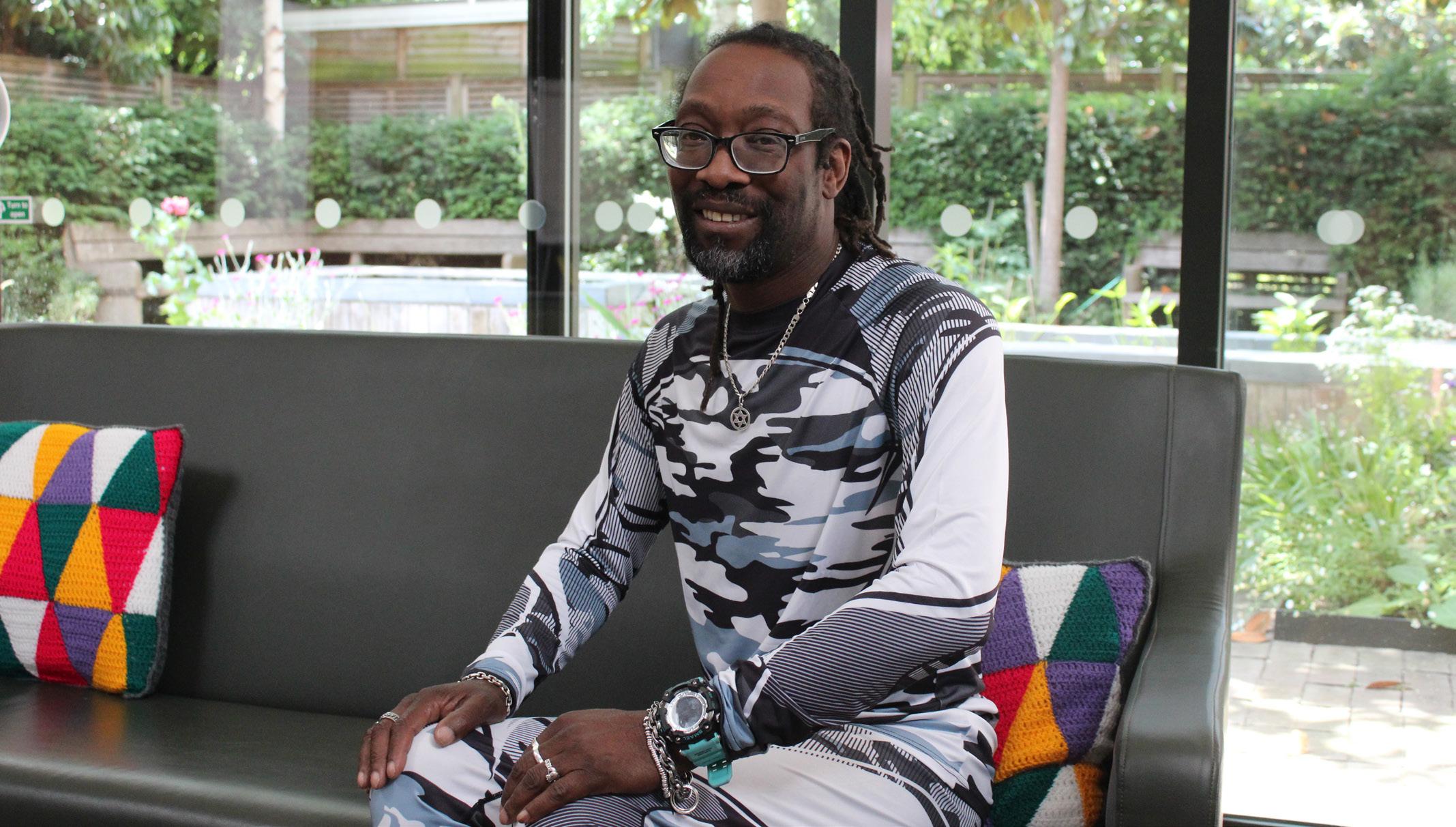
We will deliver on our long-term Financial Strategy to achieve a balanced budget by 2025
Due to external factors within the economy and sectors that we work in, we do not anticipate achieving this ambition by 2025. The Board of Trustees and Executive Team are planning a strategic and financial review in 2023/24
Strategic Objective: We will transform our hospice through investment, growth, and development
OUR 2022-23 AMBITION WHAT WE ACHIEVED
We will build organisational resilience through investment in our infrastructure
A newly refurbished area at the main entrance to the hospice opened in December 2022. Designed with patients, carers, staff, and volunteers in mind, it provides welcoming and comfortable spaces. These areas are well used and appreciated. Office accommodation has also been upgraded to provide more efficient use of space for staff who work closely together across different teams
Strategic Objective: We will innovate, engage, and actively respond to opportunities for working, sharing, and learning from each other
OUR 2022-23 AMBITION WHAT WE ACHIEVED
We will lead on partnership and collaboration with commissioners, providers, and suppliers, shaping how we design and deliver our clinical, patient, and other services that meet local need and have real impact
We have continued to work in partnership with Noah’s Ark, the Enfield Community Heart Failure team and Enfield Pulmonary Rehabilitation Service. We are also working with the North Central London Cancer Alliance on the Personal Cancer Care Programme.
Partnership working continues with the Barnet Patient Engagement Group and colleagues in Jewish Care, Healthwatch Barnet, Barnet Carers, Age UK, Dementia services, Multifaith forum and GP Patient Engagement to encourage a local conversation about preparing for end-of-life decisions and care. This year, once again, NLH worked closely to produce a public engagement campaign for Dying Matters Week
Strategic Objective: We will reduce our carbon footprint and environmental impact
OUR 2022-23 AMBITION WHAT WE ACHIEVED
We will develop and launch our commitment to the environment and introduce an improved working environment for staff and volunteers
Our refurbishment programme at Head Office has been achieved with planning around a sustainable environment. Having opened a new reception and café at Head Office in the year, we installed a range of improvements including air cooling and conditioning and energy efficient lighting creating a more pleasant environment for visitors, staff and volunteers
We will reduce waste by printing less, recycling more in the offices and in our shops, and adopting greener procurement policies
This year saw the installation of new printers across all offices, with the aim to reduce paper wastage. Our shops sold over 788,000 items of clothing through recycling – with a target of 1 million in 2023/24
We will look at measuring our energy and carbon use and delivering an annual reduction of 10%
We have unfortunately seen an increase in energy costs through the year and been unable to achieve this target. We are reviewing our energy consumption in 2023/24 – and exploring the installation of solar panels at Head Office
AMBITION 3 – Our Commitment
We will value and support our staff and volunteers to do their jobs well
Strategic Objective: We will continue to provide our staff and volunteers with enjoyable and rewarding experiences to be the best they can
OUR 2022-23 AMBITION
We will publish and deliver on a new people strategy which transforms us from a ‘good’ to a ‘great’ organisation to work or volunteer for – promoting wellbeing for all
WHAT WE ACHIEVED
Following our office refurbishment we took this opportunity to encourage employees to attend the office more regularly in-line with our Hybrid policy (60/40). Teams are working together in a hot desking capacity, encouraging collaboration, sharing ideas, and working more effectively as a group. Plans are in place to run a staff/ volunteer survey in September 2023, to build on the results of the last survey in 2021. The aim is to encourage suggestions, so we can continue to develop actions to underpin the feedback we receive. All staff have access to our EAP services to support and promote wellbeing for all. Managers have made suggestions on wellbeing through ‘time to talk sessions’, which we will continue to run to ensure that all our staff are aware of the plans we are making for wellbeing resources
We will review our staff terms and conditions and launch a new Rewards Package ensuring it continues to be attractive, affordable, and positively positioned in the market, to be an employer of choice
Our Pay and Remuneration framework was reviewed with a view to creating a system that was fair, equitable and competitive to recruit and retain a high calibre workforce across all disciplines and roles. This work was overseen by a combined Finance and People and Organisational Committee drawing on the experience and knowledge of the Trustees on these Committees.
After some initial disquiet, the review has been accepted and anxieties allayed through careful attention to detail, openness, and responsiveness on the part of Executives and Senior Managers, we launched the new North London Hospice pay structure in April 2023
We will review, develop, and implement improved processes to understand what works best for our existing staff and volunteers, and what could be improved to support retention

With the new appointment of a full-time Director of People & Culture in March 2023, a full review of all our HR and volunteer systems will be conducted to ensure we are attracting and retaining the best talent in relation to our People Strategy.
It has been established that our current HR software is not supporting our needs in relation to our HR transactional flow. Plans are in place to source a ‘fit for purpose’ HR platform to improve our employee life cycle, to deliver a more expanded people dashboard (MI), expand our employee branding and to give our line managers an easy-to-use management employee self-service linking to our payroll and volunteer data platforms
We will continue to train and develop our own professional workforce to deliver the highest level of quality and outstanding service
Mandatory training compliance averaged 94% and a wealth of additional internal courses ranging from assertiveness, coaching and mentoring, customer services and clinical skills training were offered. Continued direct mentoring, preceptorship, support and reflection opportunities were also offered by the L&D team. The addition of the career development fund also supported new learning opportunities for staff. This included the commencement of a master’s degree, a social work apprenticeship and a RGN top up degree apprenticeship. 114 mandatory and nonmandatory training sessions took place for internal staff
We will develop our leaders to not only look at performance and strategy, but also at what they can do to energise and motivate their teams to be their best
The third cohort of the Leading from the middle management training was delivered, culminating in a presentation of their work to colleagues. Work on identified goals currently continues with the support of the management group
We will create a positive culture throughout North London Hospice, where diversity, inclusion and respect are core values and at the centre of all our activities and enable us to widen our reach and diversity in terms of staff, volunteers, and patients
Contents
There has been a lot going on to improve and encourage a diversity and inclusion culture throughout NLH, which includes the following:
· Launching EDI calendar
· Inclusive leadership training on EDI
· Marking Black History Month, International Day of Persons with Disabilities, International Women’s Day
· Launching a new interpretation/translation service, Language Line
· Re-drafted interpreter guidelines for staff
· Re-launch of Count Me In data diversity campaign for staff and volunteers, resulting in response rate doubling for volunteers. Our patient ethnicity Count Me In data is 90%, after achieving this high benchmark we are now working towards mirroring this across other protected characteristics
Strategic Objective: We will ensure we train the best to be the best
OUR 2022-23 AMBITION WHAT WE ACHIEVED
We will continue to train and educate our staff, volunteers and ambassadors and explore how we can share our experience locally and nationally, across the NHS and within other organisations
Several external courses, including our accredited but also bespoke courses, were delivered virtually and in person. All received outstanding feedback including:
“Really good training by really experienced trainers, I feel motivated and engaged”
“The best training ever, it was excellent”
“The training was amazing, and I feel more confident to deliver end of life care”.
The courses also developed long standing partnerships but also created new ones, for example with the Enfield Learning Disability Team on ‘No Barriers Here’.
A poster sharing the successes, struggles and learning from the cohort of Trainee Nursing Associates was also accepted for display at the Hospice UK Conference. The hospice additionally supported one of the Nursing Associates to attend and share their growth and learning with others and was a positive individual learning experience.
In total, 106 external courses were delivered to 1074 learners
We will explore, invest, and establish a learning and development service that delivers education inside and outside of North London Hospice, where there is a positive return on investment, adds value to our work and optimises income opportunities
A business case was successful, and this allowed us to recruit to a new Clinical Educator post. This will allow for additional learning and development support of our community teams and to increase the number of external student learners we welcome into the hospice. The delivery of specialist education externally also contributed an income of £90,000 for the hospice
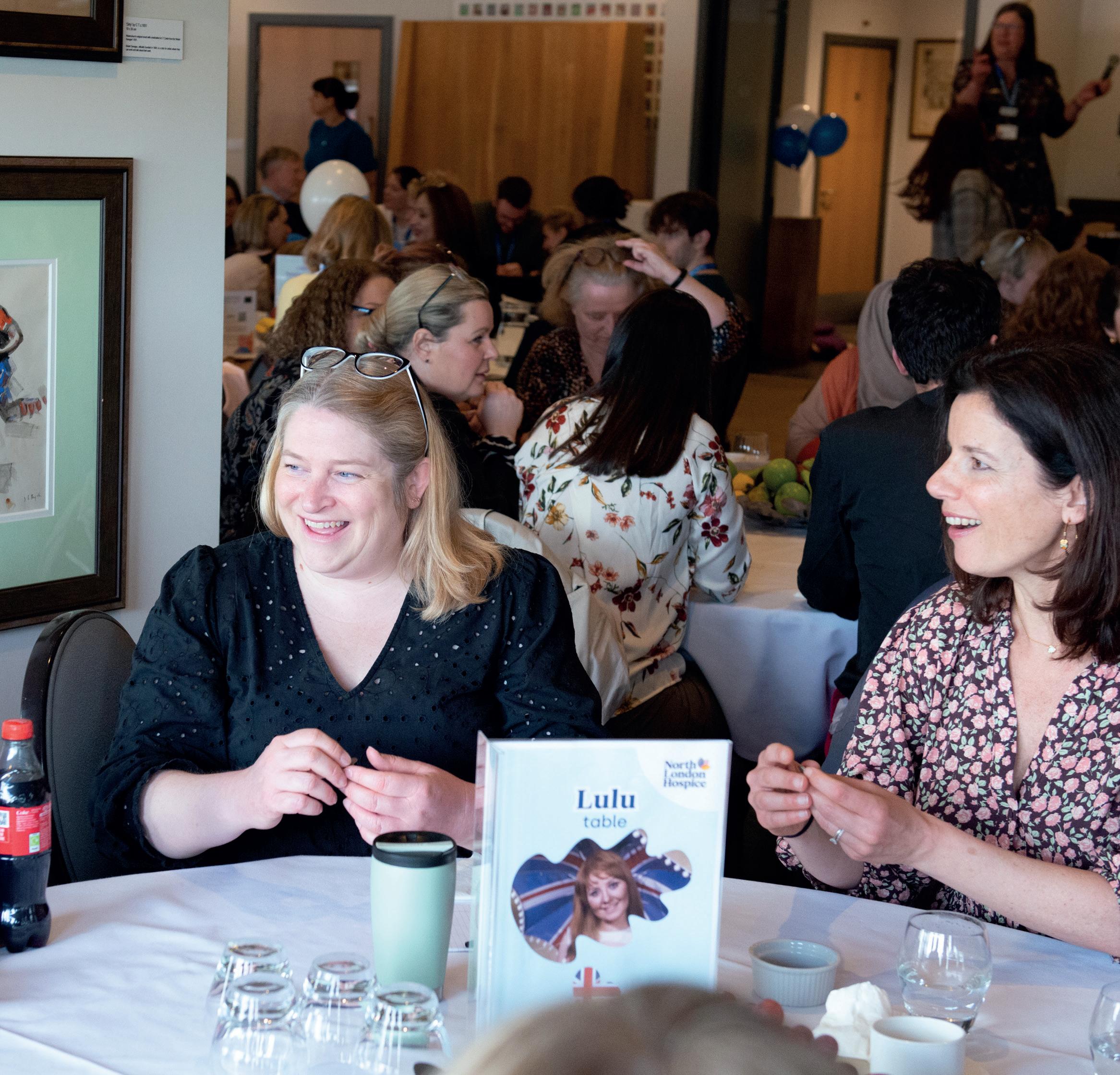
Patient Stories

Shirley’s Story
Shirley has been receiving support from North London Hospice’s physiotherapy team to help her manage her breathlessness.
Her breathing had deteriorated so much that the 81-year-old mother, grandmother and greatgrandmother found it difficult to leave her second-floor apartment.
Shirley said: “My breathing was getting worse, and it was the fear of not being able to manage if I left home that was holding me back. But the physiotherapists have given me the tools I need to help me with my breathlessness, and I am now able to go out.”

“The physiotherapists have given me the tools I need to help me with my breathlessness...”
“I thought a hospice was just for end-oflife care, but this experience has been a real eye-opener for me. The team are really helping me to make the most out of my life,”
Christian’s Story
When patient Christian, a refugee from Honduras, said he wanted to return home to spend his final days with his mother, North London Hospice pulled out all the stops to help him achieve his dying wish.
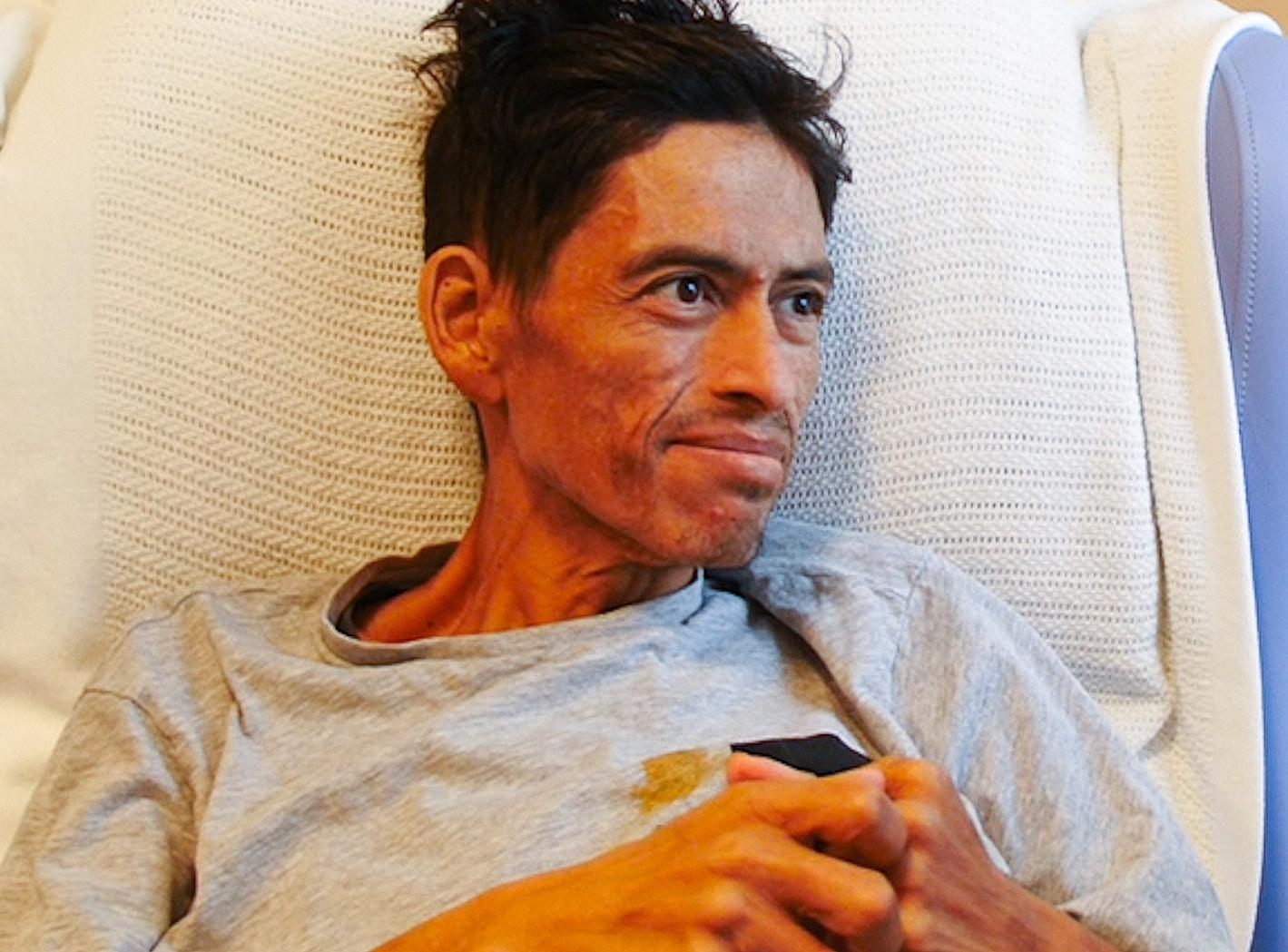
He said: “I am very grateful to the hospice staff for the care that I have received. It has been lovely to feel so well looked after and I am thankful that they are able to support me in my wish to return to my home country to be with my mother.”
Liz Perez, Patient Engagement and Experience Manager at North London Hospice added: “It was a real privilege to be part of the team caring for Christian and hopefully we made some small impact to his end-of-life care. I also think that when you have a team of people both clinical and non-clinical, cross working in this way, it creates an energy where you can collectively achieve amazing things.”
Scan the QR code to read the full story:
“I am very grateful to the hospice staff for the care that I have received. It has been lovely to feel so well looked after ...”
Fundraising
Contents
Introduction
This year has been a year of new beginnings for fundraising at the hospice. In April 2022 our fundraising function was brought entirely in-house with a new Director and significant change to the team. Anna Cooper, our new Director of Fundraising and Communications, took the opportunity to change the structure of the team and invest in experience and expertise.
Whilst the change has left us without a full team for much of the year, she has concentrated on bringing in the right experience and testing new ways to maximise our fundraising ability.
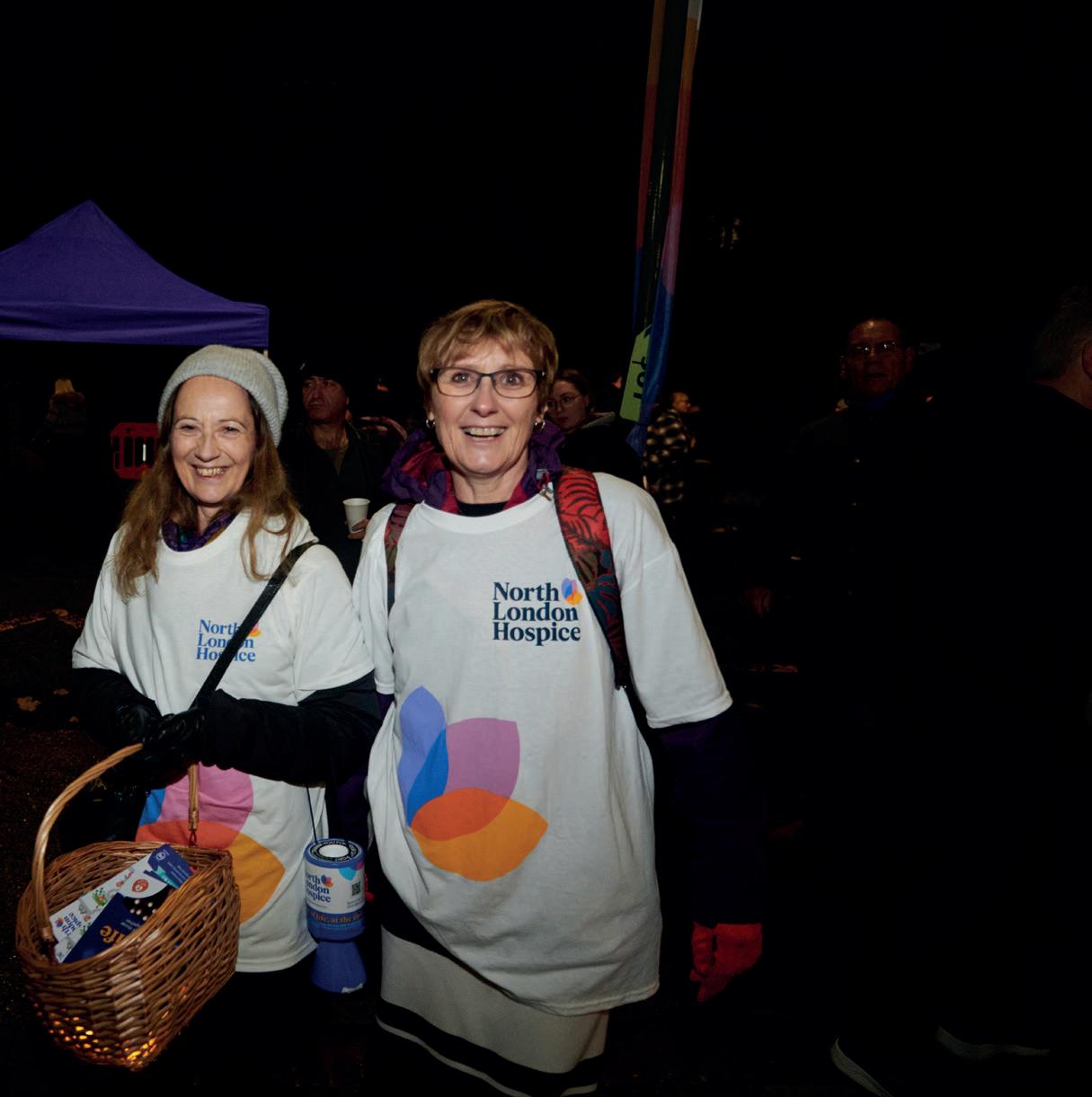
We also have trialled new ways to manage our supporter experience with a notable success from our Thankathon in January 2023 which saw staff and trustees phone many of our donors just to say thank you for their continued support. Donors had wonderful feedback about feeling appreciated and valued.
Individual Giving
This year we have concentrated on growing the numbers of people we can mail or email about the hospice. We have increased that number from 3,500 to over 12,000 people this year and have introduced ways to keep those people engaged and loyal to the hospice and our work. In 2022/23, we ran four cash appeals, including a cold door drop appeal that was sent to over 350,000 houses in our area and enabled us to reach our wider community to tell them about our vital work. Our appeals highlighted our community nursing teams and our Compassionate Neighbours programme. We also ran our annual Light up a Life Appeal whereby donors have an opportunity to remember loved ones by donating towards a light on our tree. We were sad that our chestnut tree came down during a storm in October 2022, but were happy to be able still to provide a tree to light up and a wonderful remembrance event in November. It was noted that delays following postal strikes during key fundraising moments and the cost of living crisis have impacted on income from this income stream.

Our Local Hospice Lottery programme continues with 262 players and we are looking to ramp up those numbers with a new staff member dedicated to supporting our local canvassing. We continue to work with the Local Hospice Lottery to recruit new players and increase the number of games played.
We remain thankful to each of our donors who kindly set up regular gifts for the hospicethese gifts help the hospice with longer-term, sustainable financial planning and we are looking to increase the number of committed supporters the hospice has over the next few years.
Challenge events fundraising
Challenge event participation is slowly coming back after the drop-off during Covid although the cost of living crisis has also had an impact on how comfortable people are with asking for sponsorship from friends and family. Still affected by the delays and cancellations during the pandemic, the London Marathon was again held in October 2022 rather than it’s usual April spot. The 2022 marathon saw 22 runners raise over £50k overall for the hospice. Brothers, Tom, Jack and Dan took part in the marathon and together raised £7,919 and said “The big day itself was one that we will never forget. Quite simply, it was one of the best of our lives.”
Many charities have noted reduced average gifts and take up of places since Covid and we’re no exception, but we are testing new recruitment methods and hope to see interest in mass events continue to grow as the confidence in mass events grows once again.
Over the year, a number of people took part in a range of events from running and cycling events to global challenges. Either organising the activity themselves or through a third party. Together, they raised over £40k.
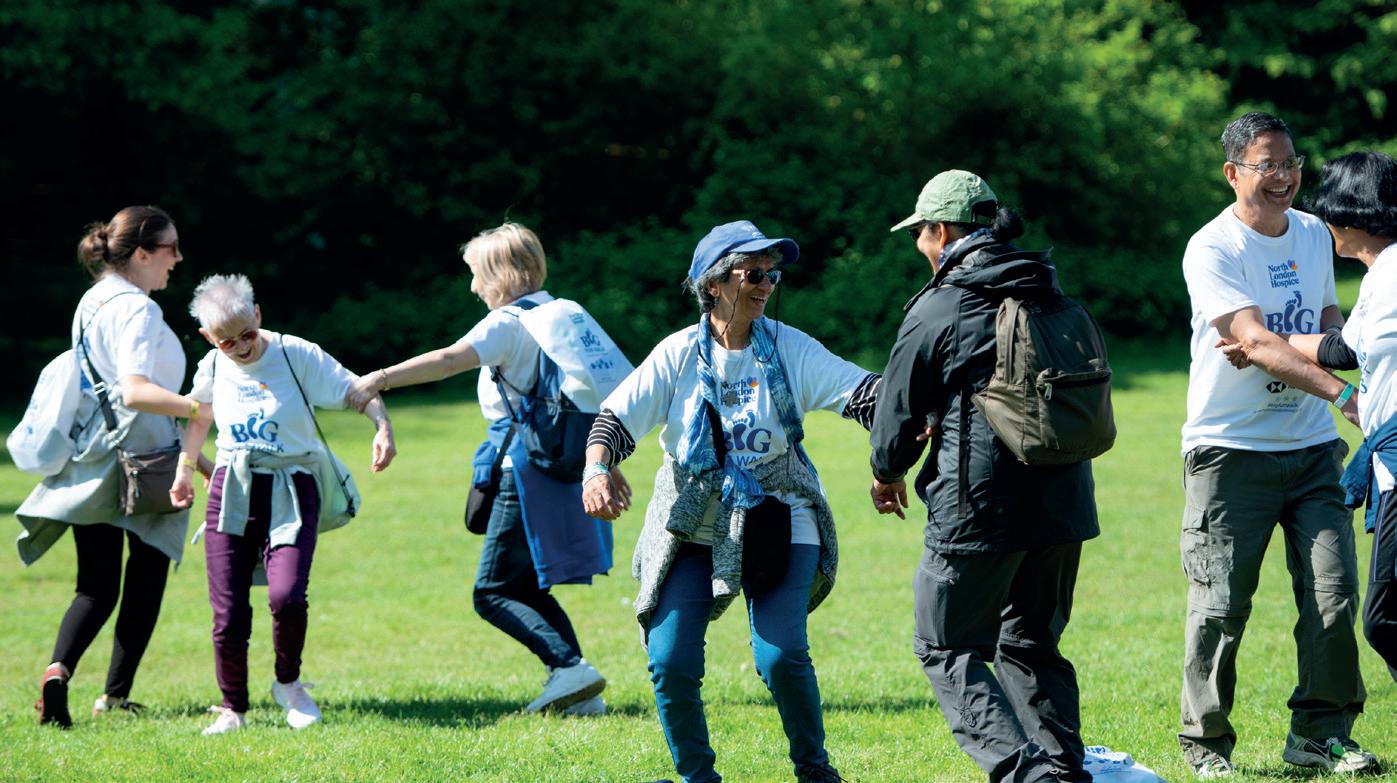
Our largest owned-event, the Big Fun Walk was finally run in person again after Covid with an incredible 1,100 Participants, who together raised an incredible £151,852 it was wonderful to be back to an in-person event this year and the take up and fundraising reflected that with our walkers. Joan Roberts takes part every year with a large team and says they are delighted to raise money for the hospice.

Contents
Community Fundraising struggled through the pandemic but this year, it has started to pick up with 269 supporter led events happening over the course of the year. We could not be more grateful for the time and effort put in by
February 2023
Knit, sew, or crochet every day this February!

Overall, more than £200k was raised over the year, which has included a variety of community-based fundraising events including Aldenham Golf Day, the opening of our Patron – Penny Gluckstein’s beautiful garden at Highwood Ash and continued support from Proms at St. Jude’s. We’ve also gratefully received support from local business, including HSBC, Nest Sewing School and SGN Retail. We remain incredibly grateful to our Support Groups and the dedicated individuals who commit their time to planning fundraisers in support of the hospice. Their decades of support are just incredible and their passion when talking of the hospice is inspiring. We’re delighted to have support from across all three boroughs in our local

Whether you are a skilled knitter and want to commit to making a jumper, or looking to pick up sewing from scratch, this challenge is perfect for you – all that’s required is one hour of your time every day!

We also have patterns you can follow – and if you make our suggested items, you can donate them to our patients or shops. Plus, getting sponsored for this challenge means the benefits will extend far beyond just you – every pound you raise will make a difference to the lives of our patients.
Join North London Hospice’s crafty community – they’re a tight knit bunch!
“Big Fun” fundraising activities, we introduced Big Fun Craft in February 2023. We tested reaching supporters via Facebook as a method to recruit new supporters and were delighted to have attracted 1,154 people to take part. Of these, only 38 were current supporters, so it was a wonderful way to bring in new support from our community. We were able to link with some of the work done by the hospice and having local corporate sponsors for the activity meant that we were able to offer in-person events and some great prize incentives to our top fundraisers. One supporter, Lilian, said “It’s been so much fun and raised
Share your designs using the hashtag #BigFunCraft
Find out more – northlondonhospice.org/events/BigFunCraft
Gifts in Wills
Gifts in Wills remain our largest single source of fundraised income. In 2022/23, we received £1.25m from 37 legators. Income was less than the previous year, but we recognise that there have been challenges within the probate service that have impacted the number of notifications we have received. We know that a gift in someone’s Will is an incredible way for them to recognise the vital support we offer to our patients and their loved ones and we are very grateful for every gift. Gifts ranged this year from £100 to £425,000.
We’d like to take this opportunity to thank those donors and their executors for administering the gifts.
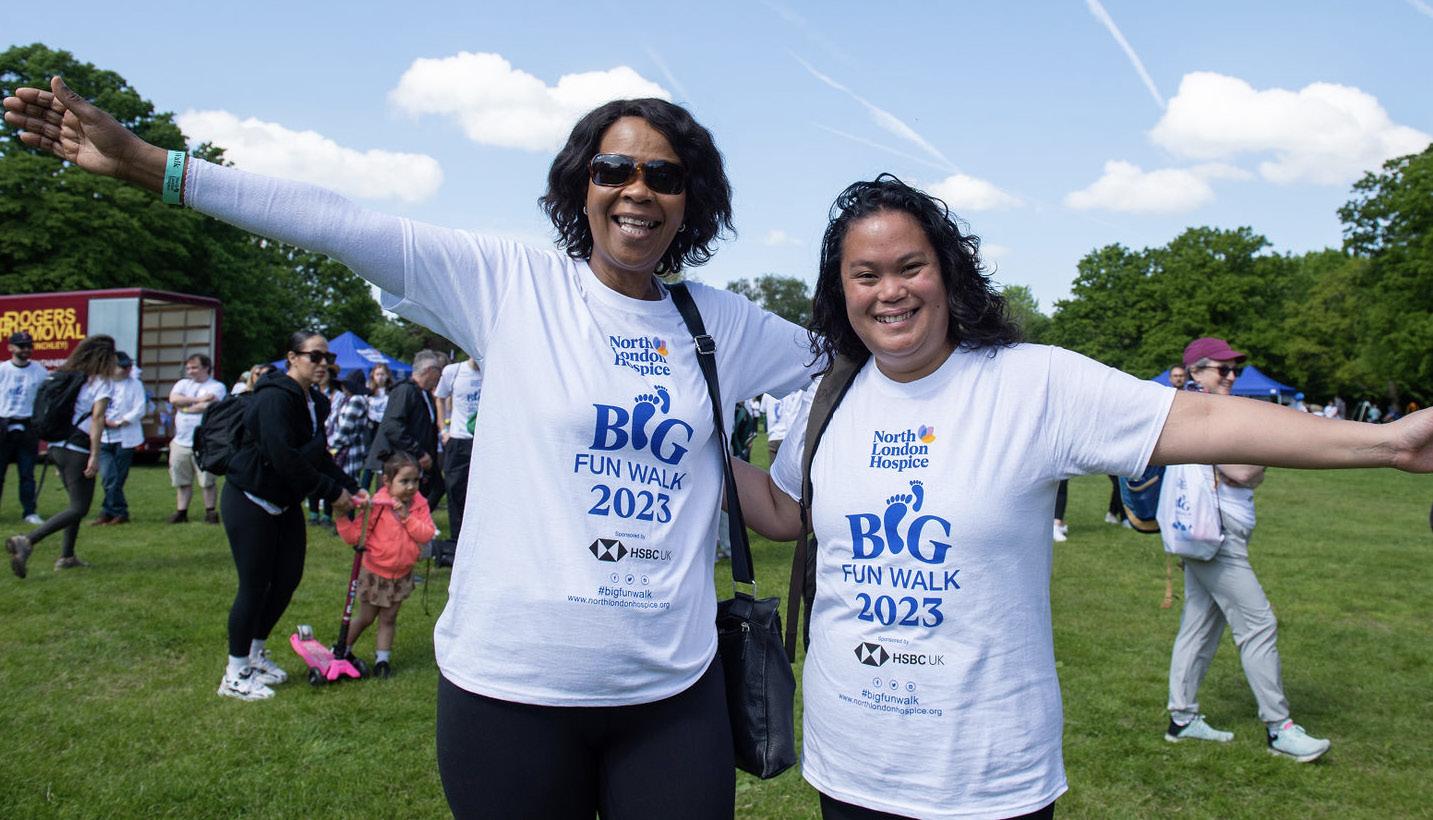
Giving in memory of a loved one
In memory giving is a very special and important income stream for the hospice and again demonstrates the high standard of care received by patients and the deep appreciation and gratitude our community has for the hospice as a result. During the year, we have repositioned our Tribute Tree giving it a great position of prominence in our reception area, however during the refurbishment we had to put the tree and leaves into storage for four months and were unable to offer new leaves to start in this time and extended the current leaves’ time mounted on the tree commensurate with the time the tree was not displayed. We mounted 33 new leaves this year. We have continued working with Much Loved and have seen that people are becoming much more comfortable with using online remembrance and collection tools.
Support from Charitable Trusts
The support of charitable trusts and foundations is essential for the work of North London Hospice. It allows us to continue providing specialist support to our patients and those who matter the most to them, at both the hospice and within the community. During the 2022/23 financial year, we received £283,337 from trusts and foundations, with gifts ranging from £50 to £50,000. Unrestricted donations from trusts and foundations totalled £197,436. During the next financial year, we look forward to further strengthening our relationships with our highly valued current supporters.
We have listed Trusts who have donated over £5,000 to the hospice during the year. We would like to thank their recognition of our work and their generous donations.


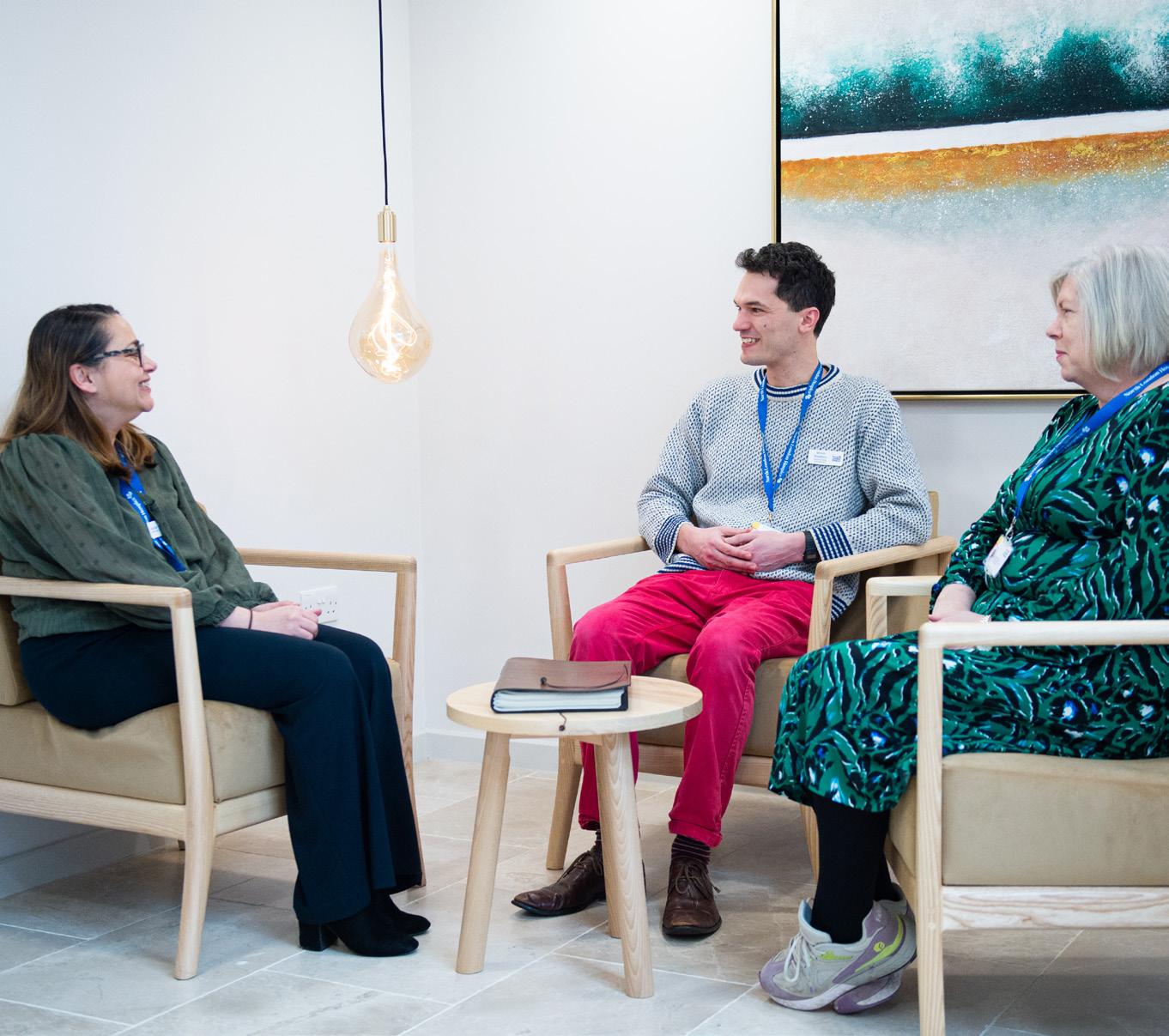
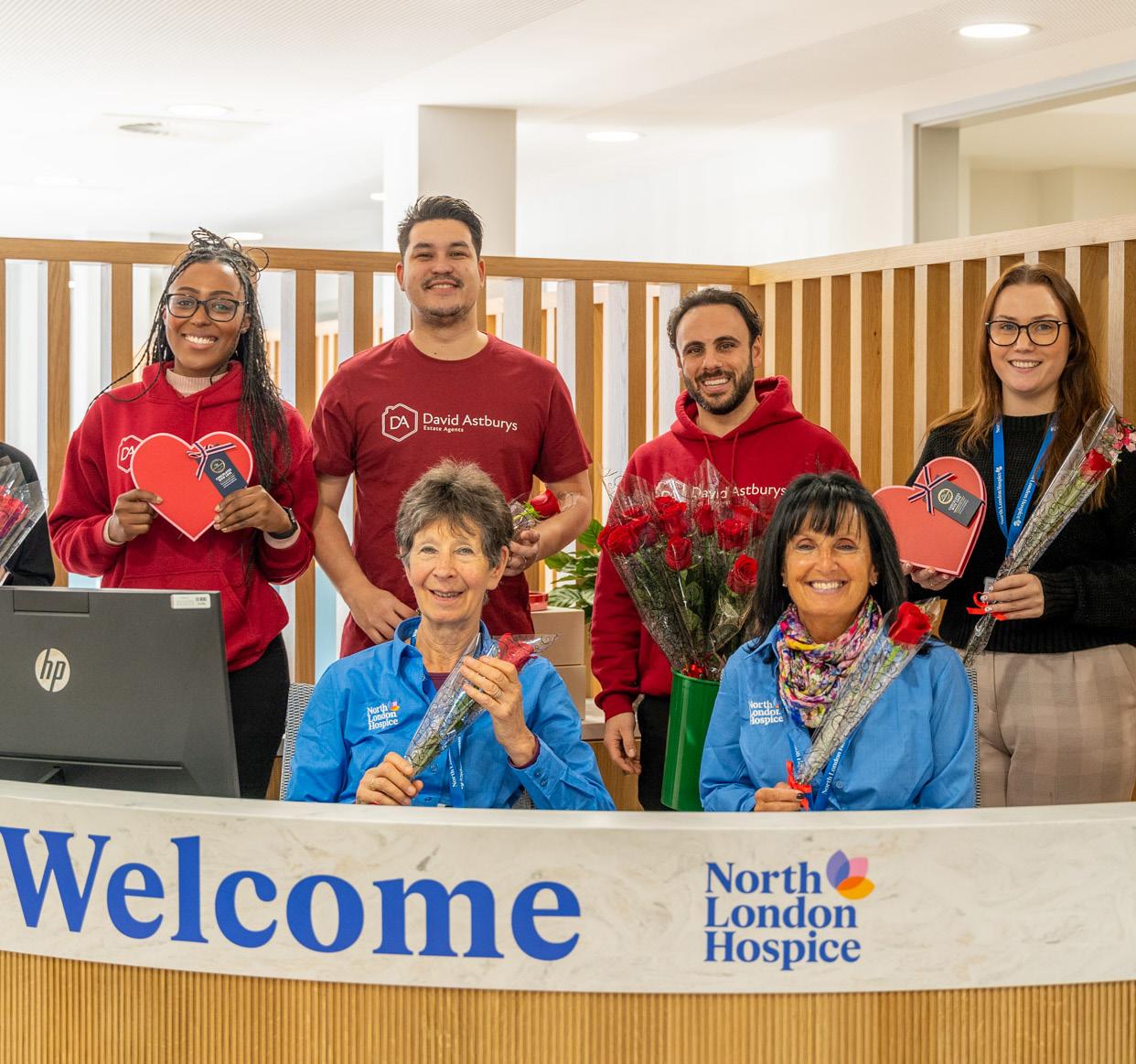
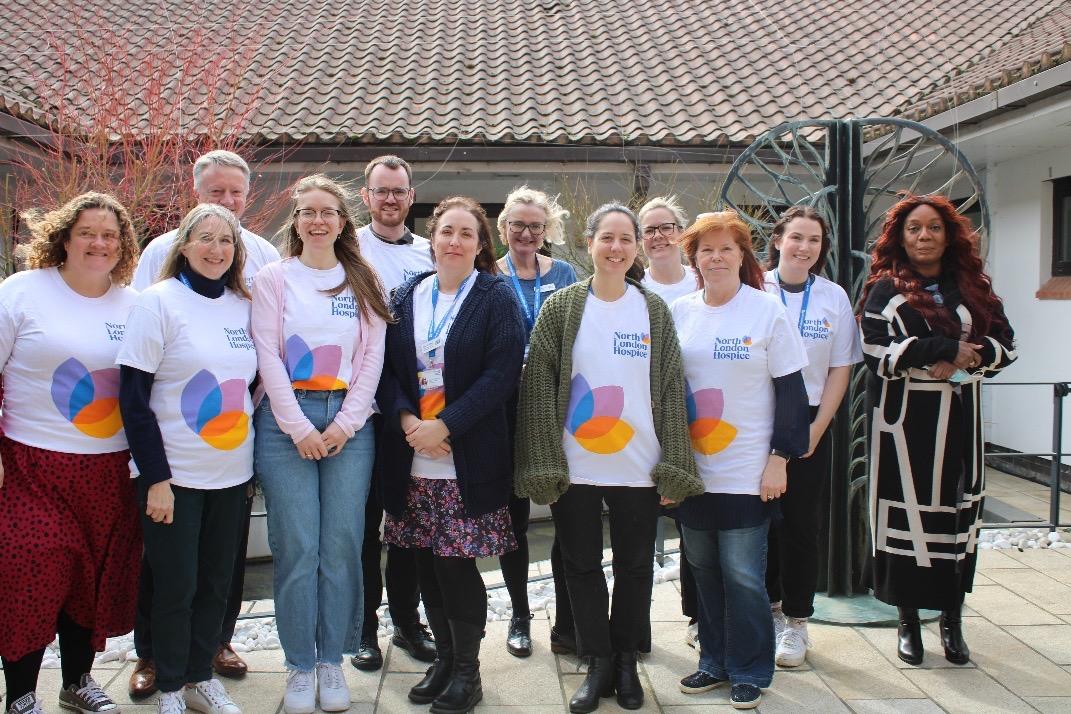
Trustees’ Annual Report for the Year ending 31 March 2023
How we are Governed
North London Hospice is a company limited by guarantee –registered number 1654807 and a registered charity in England and Wales (charity number 285300). Our constitution is our Articles of Association, which were first adopted on 29th July 1982 and amended on 13th January 2022. The hospice has a wholly owned subsidiary ‘North London Hospice’ (Trading) Limited (charity number 2268094) – the subsidiary company did not trade in the year ending 31st March 2023.
Objects, objectives, and principal activities:
The hospice’s objectives are:
• To relieve sickness and suffering and, in particular but without prejudice to the generality of the foregoing, by the establishment and maintenance of a hospice in North London for persons suffering from chronic or terminal diseases.
• To relieve the suffering of the families and friends and in particular, but without prejudice to the generality of the foregoing, by the provision of practical, bereavement and other emotional support and programmes for education and advice.
Structure, Governance & Management
Our Trustees
Our charity is governed by the Board of Trustees who are legally responsible for directing our affairs. The Board determines our long-term strategy and approves our annual strategic priorities and budget. Specific responsibilities are delegated to a number of committees which report back to the Board on a regular basis. The Board delegates day to day management of the charity to the Chief Executive and the Executive Team.
During the year under review – no Trustees retired or were recruited, although we did have two very valuable colleagues retire from office in June 2023 - Carol Holmes and Jennifer Walters - both of whom have offered very valuable skills and insight to the Board and Executive Team and will be sadly missed - thank you both for your loyalty and support.
New Trustees will be recruited in 2023 through a process of advertisement, application, and interview, based on a range of selection criteria to seek a diverse variety of skills and experience. We will offer those appointed a tailored induction programme, including interaction with our services, and meetings with the Chief Executive and members of the Executive Team. All Trustees are asked to complete e-learning on a set of key areas and Trustees are not remunerated for their services.
All Trustees complete an annual appraisal process with the Chair and Vice Chair together with completion of our Fit & Proper Persons declaration and approved Code of Conduct.
Governance
The Committee framework, introduced last year, has been integrated positively into our governance structures. Each Trustee is required to disclose potential or actual conflicts of interest to the charity as part of an annual review and at the start of each meeting. The Board continues to adopt the principles of good governance in the Charity Governance Code. These principles underpin the Board’s governance and form an integral part of the programme of change we have undertaken. The Trustees have taken account of the Charity Commission’s general guidance on public benefit when reviewing our aims, objectives, and planning.
Board Committees
Board Development Committee
– responsible for Board governance arrangements and succession planning and recommendations for the appointment and reappointment of governance and executive positions. Oversight of the performance of and recommendations on the remuneration of the Chief Executive and Executive Team.
Finance & External Audit Committee
– responsible for the strategic oversight and effective use of the charity’s financial resources and investments. To oversee associated policy, strategy, and performance across all finance and investment areas.
Clinical Governance & Assurance Committee
Contents
– responsible for strategic oversight of the charity’s clinical and patient services to ensure they are safe, effective, caring, responsive and well-led. Provide assurance to the Board on all aspects of the quality of clinical care, clinical risk management, clinical governance systems, compliance with clinical regulatory requirements and standards of quality and safety. To oversee associated policy, strategy, and performance in all clinical areas.
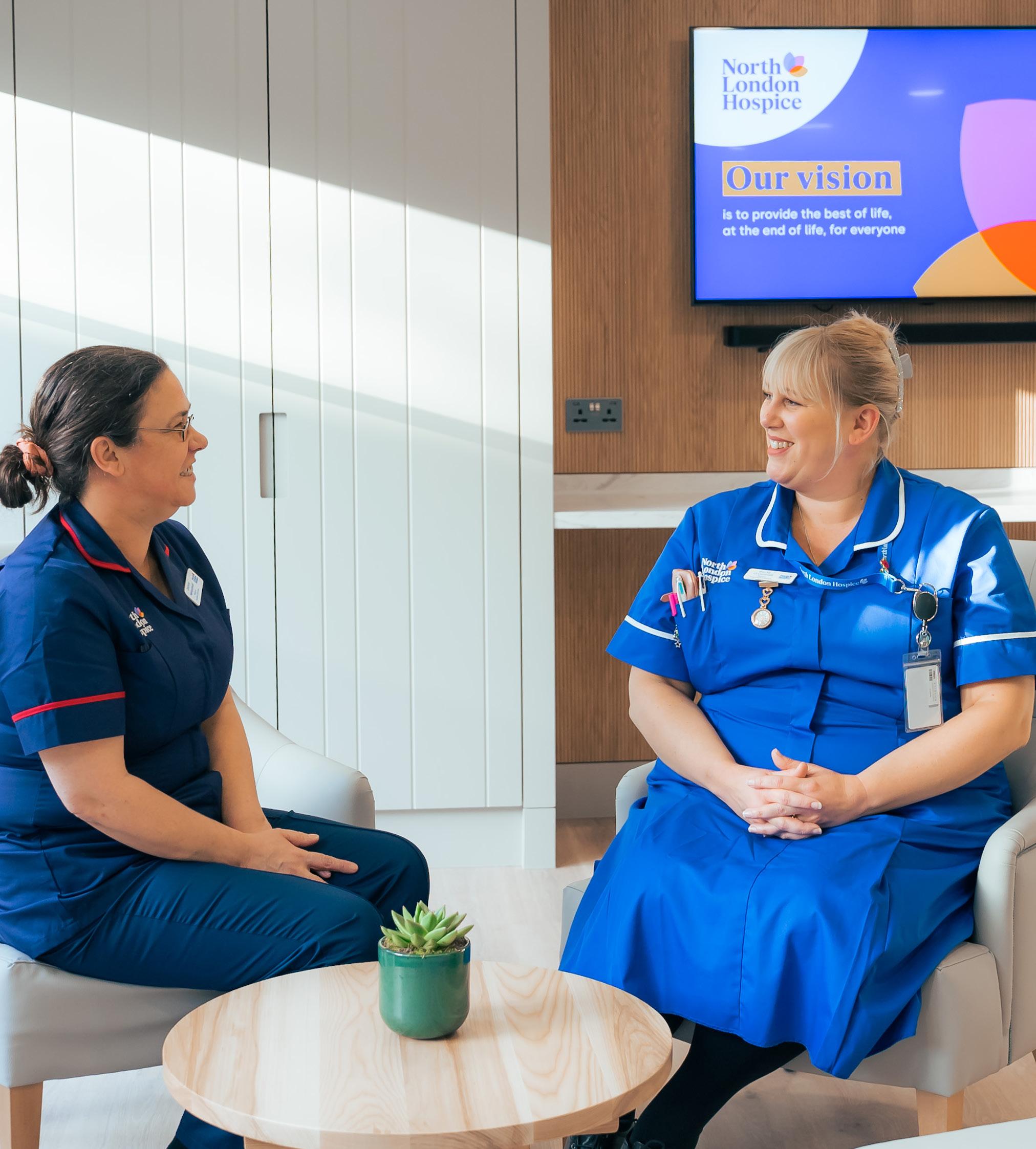
Fundraising Committee
– responsible for strategic oversight of the fundraising delivery and services. To oversee associated policy, strategy, and performance across all fundraising income areas.
People and Organisational Development Committee
– responsible for oversight and delivery assurance of the People, Equality, Diversity & Inclusion strategy, and Volunteering. To oversee associated policy, strategy, and performance across all people (staff & volunteer) areas.
Retail Committee
– responsible for development and delivery of the retail strategy, exploring shop growth with return on investment and overseeing associated policy, strategy and performance across the retail areas.
Please see page 66 for a full list of Trustees, which also shows movements through the year under review.
Statement of Trustees’ Responsibilities and Corporate Governance
The Trustees are responsible for their annual report, and for the preparation of accounts for each financial year which give a true and fair view of the incoming resources and application of those resources during the year, and of the state of affairs as at the end of the financial year. In preparing these accounts, the trustees are required to:
• ensure that suitable accounting policies are established and applied consistently;
• make judgements and estimates which are reasonable and prudent;
• state whether applicable accounting standards and statement of recommended accounting practice have been followed, subject to any material departures disclosed and explained in the accounts;
• prepare the accounts on a going concern basis unless it is inappropriate to presume that the hospice will continue in operation
The Trustees confirm that they have complied with the above requirements in preparing the accounts.
The Trustees have overall responsibility for ensuring that the hospice has appropriate systems and controls, financial and otherwise. They are also responsible for keeping proper accounting records which disclose with reasonable accuracy at any time the financial position of the hospice and enable them to ensure that the accounts comply with the Companies Act 2006. They are also responsible for safeguarding the assets of the hospice and for their proper application as required by charity law, and hence for taking reasonable steps for the prevention and detection of fraud and other irregularities and to provide reasonable assurance that:
• the hospice is operating efficiently and effectively;
• all assets are safeguarded against unauthorised use or disposition and are properly applied;
• proper records are maintained and financial information used within the hospice, or for publication, is reliable;
• the hospice complies with relevant laws and regulations.
Reserves Policy
The Trustees recognise that the current level of reserves is higher than policy and planned. This does however, give Trustees the assurance with deficits forecast in the 2023-25 planning cycle, general unrestricted reserves are likely to be above the 12 months operating expenditure level while investing in our infrastructure and expanding our reach and the services the hospice offers to its patients and their families, thereby increasing the hospice’s baseline costs.
Accordingly, the existing policy is at a level that the Trustees consider will be adequate. The policy is to always maintain unrestricted reserves at a minimum of nine months of unrestricted operating expenditure, taking account of future forecasts.
Current levels of expenditure and maintaining our unrestricted general fund will ensure longterm financial stability and enable the hospice to withstand external events which may affect the level of income received. Planned investment from reserves as part of our strategic priorities in 2023-25 will result in the reduction of the current level of unrestricted general fund.
Investment Policy
The Memorandum and Articles of Association do not place any restrictions on the investment policy to be adopted. The Trustees have invested surplus funds, whilst ensuring easy access to meet the operating costs of the hospice. Specific investment powers are delegated to Newton Investment Management Limited under the following restrictions:
• No investment in tobacco stocks, unquoted shares, derivatives, or unregulated collective investment schemes;
• Investments are consolidated in Newton Fund for Charities, effectively holding units in a highly diversified but readily accessible portfolio
Principal Risks & Uncertainties
The Board of Trustees has overall responsibility for risk management of North London Hospice. This includes setting the risk appetite for the charity, ensuring there are reasonable procedures in place for the prevention and detection of major risks, including fraud risk and other irregularities, and ensuring that risk procedures are reviewed when issues arise.
During the year under review, we again improved our risk management processes, and our committee and governance structure was strengthened to help us manage our approach to mitigating against risk across North London Hospice.
• North London Hospice committee groups meets quarterly to oversee key risk areas, including information governance and data privacy, fraud, and bribery, safeguarding and business continuity. Risks are escalated as appropriate.
• Each directorate meets regularly, to carry out reviews of risk management arrangements across the directorate and inform the escalation of the risk to the Executive Team/ Board
• The Executive Team, chaired by the Chief Executive, regularly reviews and monitors key charity-wide strategic and operational risks at its fortnightly meetings.
• The Clinical Governance and Assurance Committee scrutinises the management of clinical risks, and the monitoring of clinical incidents and trends.
• Each committee reviews the results of the executive risk management and the operation of our risk management processes. Each committee review and deep dive into selected key risks as necessary.
In addition, we have policies and procedures to identify and manage risks arising from our existing operations and strategic development, and to provide reasonable assurance against material errors or loss.
Planning & Performance
We operate a comprehensive annual planning and budgeting process. We monitor performance through use of key financial and performance indicators which compare actual results and activity against our plans and are routinely reported to the Board of Trustees. A phased budget and regular forecasting enable the Trustees and the Executive Team to link financial performance with resource and activity levels. The Finance & External Audit Committee has delegated oversight into this area.
A review of our data collection and reporting is planned in 2023/24 - to improve both presentation, scrutiny and assurance.
Internal Audit
Internal controls are subject to scrutiny by each committee – we carry out a programme of cyclical reviews throughout North London Hospice. The Executive Team approves and presents the annual audit plan, scrutinise regular reports and present to each committee on progress against the audit plan, the effectiveness of controls in audited functions, and recommendations and learnings from audits.
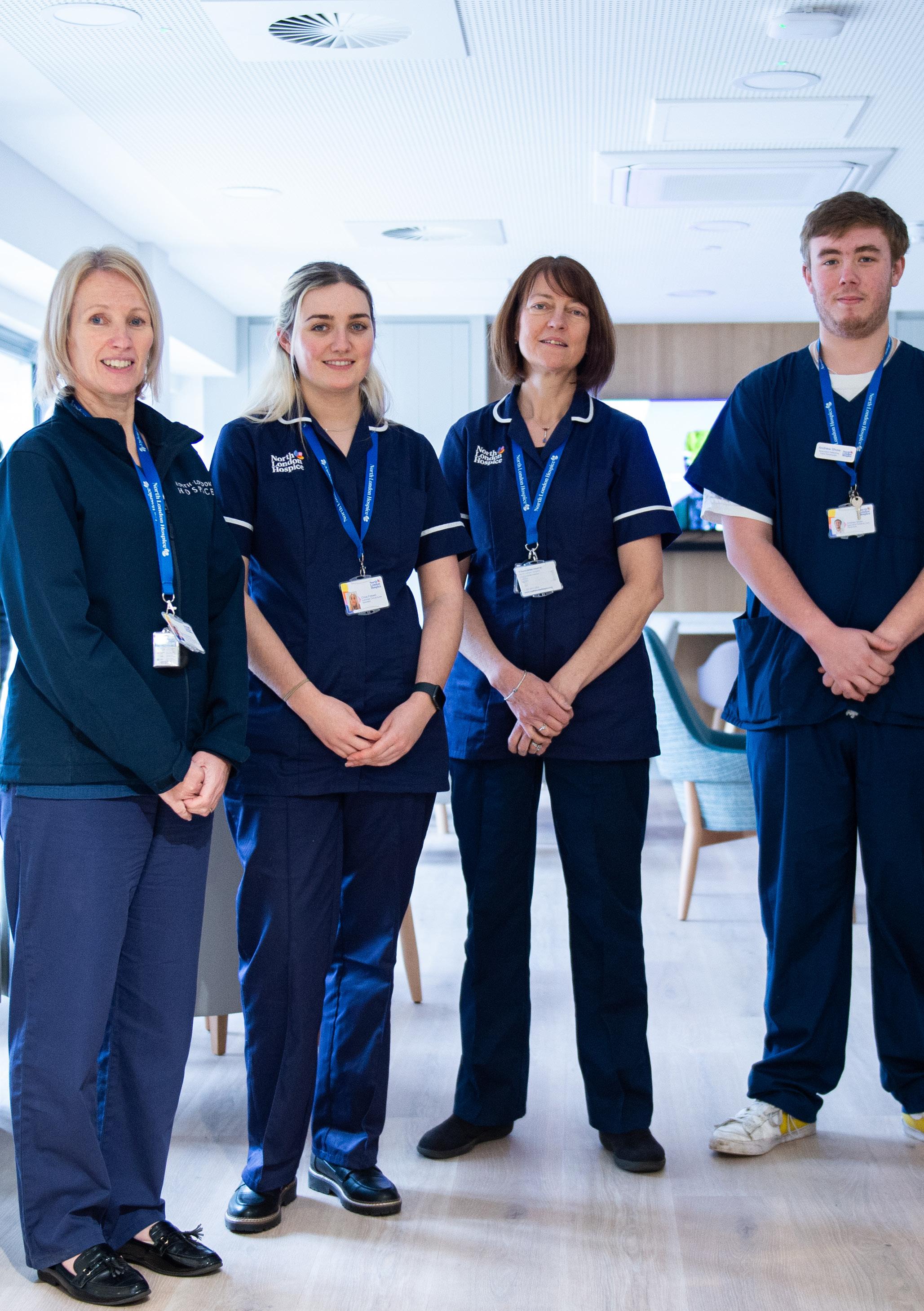
Key Strategic Risk
Contents
An overview of our key strategic risks for 2022/23 and the actions we have taken to mitigate them is summarised in the table below. Each risk area is supported by relevant policies and procedures that are regularly reviewed and updated, and subject to compliance testing.
Risk How we manage it
CORONAVIRUS
– that coronavirus continues to significantly impact upon our ability to deliver services
Risk closed in December 2022
FINANCIAL SUSTAINABILITY
– risk that the charity has insufficient funds to deliver plans to sustain services
• Business continuity meetings to manage ongoing issues as they arise and to seek to mitigate the risks coronavirus presents to our future
• Executive Team leadership and discussion
• Clinical Governance & Assurance Committee
• Regular monitoring of income and expenditure and regular financial planning and review
• Internal financial controls and policies
• Diversification of income streams and maintenance of prudent financial reserves
• Expert external management of investments
• Charity-wide assurance groups
SERVICE QUALITY
– risk of quality failure that may result in patient or user harm
• Robust clinical governance processes and oversight
• High quality specialist training for staff
• Quality reviews and compliance checks
• Reviewing and action of patient and carer feedback, incidents and complaints, and trends
• Proactive engagement with partners
STRATEGY AND CHANGE
– risk that the charity is unable to adapt to the changing environment it works in, without clear strategic and operating plans, which may well lead to reduced ability to deliver the highest impact
PEOPLE, CULTURE, WELLNESS
– risk that the charity is unable to recruit, retain and support suitable staff or sustain a culture that supports the delivery of its strategy
• Strategic plan 2021-25 - and reporting against achievements, failures and learning
• Board of Trustees oversight of strategy and delivery of operational plans - strategic awaydays
• Executive Team and Board oversight of significant change programmes
• Balanced scorecard reporting
• Learning and Development programmes
• Benchmarking of remuneration and benefits
• Comprehensive and innovative recruitment methods
• Staff and volunteer engagement surveys and forum feedback mechanisms
• Equality, Diversity & Inclusion Strategy, action plan and forum
• Freedom to Speak Up Guardians
• Access to Employee Assistance Programme & Occupational Health
• People Strategy – 2021 - 2025
Risk How we manage it
SAFEGUARDING
– risk that inability to safeguard vulnerable adults may lead to serious harm/abuse
GOVERNANCE & COMPLIANCE
– risk that failures in governance or compliance may lead to poor decision making, or legal or regulatory action
HEALTH & SAFETY & THE ENVIRONMENT
– risk that failures to act in accordance with guidance could cause harm, negatively impact service delivery and lead to legal or regulatory action
DATA GOVERNANCE, SECURITY, PRIVACY AND QUALITY
– risk that inadequate systems for the governance, privacy and security of data may lead to harm, negatively impact service delivery and lead to legal or regulatory action
INFRASTRUCTURE
– risk that core systems and technology are inadequate to serve strategy and service needs
REPUTATION
– risk that incidents or events may damage or negatively impact our reputation or operations
• Safeguarding leads within the charity
• Safe recruitment practices, including pre-employment checks and screening
• Regular role-specific mandatory safeguarding training
• Promotion of Freedom to Speak up Guardians
• Clinical Governance & Assurance Committee and charity-wide assurance groups to monitor standards, performance, service developments, incidents, and complaints
• Board Governance Structures
• Policies, procedures, and guidance supported by training and specialist roles
• Charity wide Health & Safety Group and external consultant & advisor
• Project group to examine environmental impact of our activity
• Green Pledge
• Privacy and security impact assessments for all new business initiatives
• Security audits and reviews
• Mandatory training and guidance for all staff
• Specialist roles – Senior Information Risk Officer, Data Protection Officer, Caldicott Guardian
• Information Governance Group – through business continuity policy
• Internal audit and self-assessment
• External testing and benchmarking
• Continuous improvement programmes
• IT support and new strategy
• Business continuity plan
• Executive Team meetings
• Public liability and professional indemnity insurance
• Communications Team
NLH receives complaints about clinical and non-clinical (charity shops) aspects of its business. This year we received a total of 21 complaints:

• 13 were clinical (patient service) 5 were retail, 2 related to facilities, 1 related to social worker services
The 13 clinical complaints involved our Inpatient Unit, Community teams and PCSS service. Less than 1% of patients and families supported by NLH this year made a complaint.
The themes of clinical complaints raised this year were predominantly communication of staff to service users and care of patients.
Financial Review of the Year
Whilst the previous year saw a healthy surplus, thanks largely to a £1.1 million increase in the value of investments and certain Covid-related grants, the current year has proved more challenging. Unexpectedly, legacy income received was around 50% of the long-term average, investments saw a fall of over £0.5m and inflationary pressures continue to be seen in many areas of expenditure. As the charity approaches the midpoint of a 5-year strategy, it will continue to undertake a review of the impact achieved alongside a sustainability review, which will enable the charity to continue to offer ‘The best of life at the end of life, for everyone’.
Total net movement in funds saw a reduction of £3.0 million in the year ended 31 March 2023 (2022: £2.6 million surplus). Of the total net reduction in funds, £2.9 million (2022: £2.3 million surplus) was unrestricted.
Total incoming resources were £12.1 million in the year ended 31 March 2023, compared with £15.0 million in the year ended 31 March 2022.
Total donations and fundraising were £1.7 million, of which £0.1 million is restricted income. This was a reduction of £1.1m from the previous year, which included some additional Covid grants/ donations, but was in line with average yearly donations from 16/17 to 20/21 of £1.7 million.
Legacy income of £1.3 million in 2023 was £1.2 million lower than the previous year. With legacy receipts fluctuating from year to year the charity will continue to forecast based on a 10-year average of legacy income.
Total grants income was £5.2 million compared with £5.9 million in the previous year of which £1.3 million (2022: £2.1 million) was restricted.
This reduction reflects the additional grants received in prior year and not in FY22-23, primarily NHSE Covid-19 Emergency Funding of £1m.
Other trading activities reflect the charity shops operations, made up of sales of £3.0 million (2022: £2.8 million), donations of agency sales and Gift Aid of £485K (2022: £626K) and rental income of £12K (2022: £12K).
Investment income of £319K was £77K higher than the previous year, offsetting a net loss on the value of the investments of £511K, reflecting the current economic climate and a fall in market valuation. Prior year investment gains totalled £1.1m.
Total expenditure was £14.5 million, compared with £13.5 million in the previous year. With inflationary pressures continuing to have a significant impact on expenditure the charity is aware that long term deficits are unsustainable and will look to seek a balanced budget within 3 years.
The current year included one-off investments in infrastructure and additional staff payments, alongside various items of expenditure in clinical services approved by the Board. It allowed for the continuation of clinical services funded by the NHS as part of the Sustainability and Transformation Partnerships (STP) and the newly commissioned Single Point of Access (SPA) Service. The continuing rise in inflation has proved challenging for the charity and continues to affect all lines of expenditure.
During the year the hospice utilised the help of over 600 volunteers across all services. The value of this work is difficult to quantify but is crucial to continuing the work of the hospice at its current level.
Position of the Charity at the End of the Year
Contents
The unrestricted general fund at the year-end represented some 16 months of underlying unrestricted expenditure and is above the reserves policy of holding at least 9 months of unrestricted expenditure.
Principal Risks and Uncertainties
As referred to in the message from the Chair and Chief Executive, there are continuing challenges facing all hospices, to which North London Hospice is not unique. Whether that is uncertainty regarding the levels of future NHS funding, inflationary pressures or increasing fundraising targets, all of these have a part to play in ensuring North London Hospice continues to deliver the wide range of services that are currently supported. The hospice will continue to look to invest reserves in areas which result in quality improvements in patient care.
Public Benefit Statement
The Trustees confirm that they have complied with the duty in section 17 of the Charities Act 2011 to have due regard to the Charity Commission’s general guidance on public benefit, “Charities and Public Benefit”.
North London Hospice’s objects comply directly with two of the Charities Act’s descriptions of “charitable purpose”:
• “the advancement of health” and
• “the relief of those in need, by reason of youth, age, ill-health, disability, financial hardship or other disadvantage”
The hospice’s charitable purpose is enshrined in the wording of the hospice’s objects.
The Trustees ensure that this purpose is carried out for the public benefit by delivering services that are valued by our patients, their families and friends and the community in general.
Hospice services are available to those most in need of the services in the London boroughs of Barnet, Enfield, and Haringey. The hospice provides specialist palliative care in an inpatient, outpatient and therapies and community setting.

Disclosure of Information to the Auditor
As far as the Trustees are aware, there is no relevant information of which the company’s auditor is unaware. The Trustees have taken all the steps that they ought to have taken as Trustees to make themselves aware of any relevant audit information and to establish that the company’s auditor is aware of that information.
Approved by the Board of Trustees on 5 September 2023 and signed on its behalf by:
ELISABETH BURGESS JONES Chair ANDREW J. HARRIS Company Secretary and Honorary Treasurer
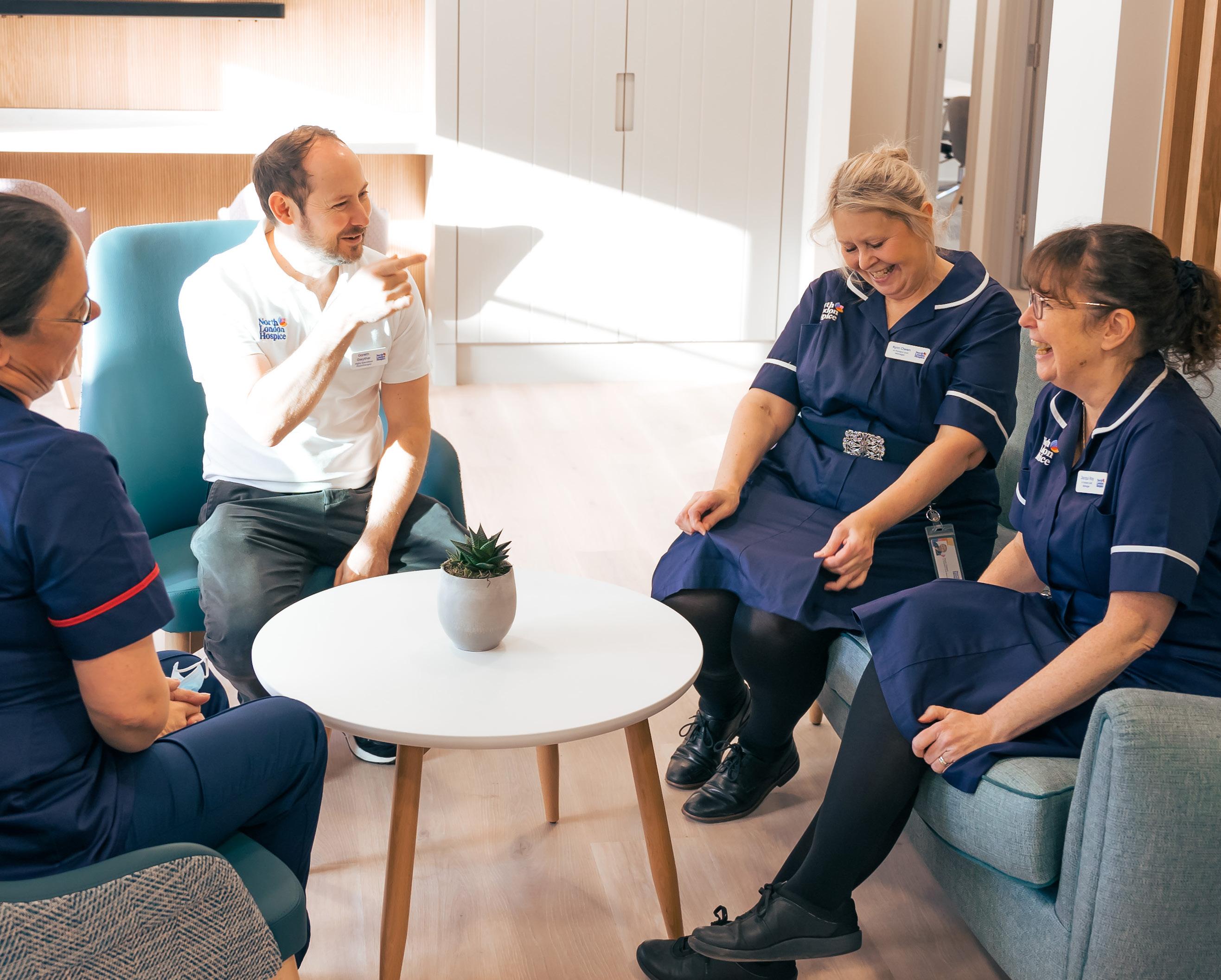
Independent Auditors Report to the Members of North London Hospice
Opinion
We have audited the accounts of North London Hospice (the 'charitable company') for the year ended 31st March 2023 which comprise the statement of financial activities, the balance sheet, the statement of cash flows, the principal accounting policies and the notes to the accounts. The financial reporting framework that has been applied in their preparation is applicable law and United Kingdom Accounting Standards, including “The Financial Reporting Standard Applicable in the UK and Republic of Ireland”(United Kingdom Generally Accepted Accounting Practice).
In our opinion the accounts:
• give a true and fair view of the state of the charitable company's affairs as at 31st March 2023, and of its and expenditure for the year then ended;
• have been properly prepared in accordance with United Kingdom Generally Accepted Accounting Practice;
• have been prepared in accordance with the requirements of the Companies Act 2006.
Basis for opinion
We conducted our audit in accordance with International Standards on Auditing (UK) (ISAs (UK)) and applicable law. Our responsibilities under those standards are further described in the auditor’s responsibilities for the audit of accounts section of our report. We are independent of the charitable company in accordance with the ethical requirements that are relevant to our audit of the accounts in the UK, including the FRC’s Ethical Standard, and we have fulfilled our other ethical responsibilities in accordance with these requirements. We believe that the audit evidence we have obtained is sufficient and appropriate to provide a basis for our opinion.
Conclusions relating to going concern
In auditing the accounts, we have concluded that the Trustees’ use of the going concern basis of accounting in the preparation of the accounts is appropriate.
Based on the work we have performed, we have not identified any material uncertainties relating to events or conditions that, individually or collectively, may cast significant doubt on the charitable company’s ability to continue as a going concern for a period of at least twelve months from when the accounts are authorised for issue.
Our responsibilities and the responsibilities of the Trustees with respect to going concern are described in the relevant sections of this report.
Other information
The other information comprises the information included in the Trustees’ annual report, including the strategic report and the impact report, other than the accounts and our auditor’s report thereon. The trustees are responsible for the other information contained within the annual report. Our opinion on the accounts does not cover the other information and, except to the extent otherwise explicitly stated in our report, we do not express any form of assurance conclusion thereon.
Our responsibility is to read the other information and, in doing so, consider whether the other information is materially inconsistent with the accounts or our knowledge obtained in the audit or otherwise appears to be materially misstated. If we identify such material inconsistencies or apparent material misstatements, we are required to determine whether there is a material misstatement in the accounts themselves. If, based on the work we have performed, we conclude that there is a material misstatement of this other information, we are required to report that fact. We have nothing to report in this regard.
Opinions on other matters prescribed by the Companies Act 2006
In our opinion, based on the work undertaken in the course of the audit:
• the information given in the Trustees’ annual report which is also the directors’ report for the purposes of company law, and includes the strategic report and the impact report for the financial year for which the accounts are prepared is consistent with the accounts; and
• the Trustees’ report, which is also the directors’ report for the purposes of company law, and includes the strategic report and the impact report have been prepared in accordance with applicable legal requirements.
Matters on which we are required to report by exception
In the light of the knowledge and understanding of the charitable company and its environment obtained in the course of the audit, we have not identified material misstatements in the Trustees’ annual report including the strategic report and the impact report. We have nothing to report in respect of the following matters in relation to which the Companies Act 2006 requires us to report to you if, in our opinion:
• adequate accounting records have not been kept by the charitable company, or returns adequate for our audit have not been received from branches not visited by us; or
• the charitable company’s accounts are not in agreement with the accounting records and returns; or
• certain disclosures of trustees’ remuneration specified by law are not made; or
• we have not received all the information and explanations we require for our audit.
Responsibilities of Trustees
As explained more fully in the Trustees’ responsibilities statement set out on page 33, the Trustees (who are also the directors of the charitable company for the purposes of company law) are responsible for the preparation of the accounts and for being satisfied that they give a true and fair view, and for such internal control as the Trustees determine is necessary to enable the preparation of accounts that are free from material misstatement, whether due to fraud or error.
In preparing the accounts, the Trustees are responsible for assessing the charitable company’s ability to continue as a going concern, disclosing, as applicable, matters related to going concern and using the going concern basis of accounting unless the Trustees either intend to liquidate the charitable company or to cease operations, or have no realistic alternative but to do so.
Auditor’s responsibilities for the audit of the accounts
Contents
Our objectives are to obtain reasonable assurance about whether the accounts, as a whole, are free from material misstatement, whether due to fraud or error, and to issue an auditor’s report that includes our opinion. Reasonable assurance is a high level of assurance but is not a guarantee that an audit conducted in accordance with ISAs (UK) will always detect a material misstatement when it exists. Misstatements can arise from fraud or error and are considered material if, individually or in the aggregate, they could reasonably be expected to influence the economic decisions of users, taken on the basis of these accounts.
Irregularities, including fraud, are instances of non-compliance with laws and regulations. We design procedures in line with our responsibilities, outlined above, to detect material misstatements in respect of irregularities, including fraud. The extent to which our procedures are capable of detecting irregularities, including fraud is detailed below:
How the audit was considered capable of detecting irregularities including fraud
Our approach to identifying and assessing the risks of material misstatement in respect of irregularities, including fraud and non-compliance with laws and regulations, was as follows:
• The engagement partner ensured that the engagement team collectively had the appropriate competence, capabilities and skills to identify or recognise non-compliance with applicable laws and regulations;
• We identified the laws and regulations applicable to the charity through discussions with management and trustees and from our knowledge and experience of the charity sector;
• We focused on specific laws and regulations which we considered may have a direct material effect on the accounts or the activities of the charity. These included but were not limited to the Companies Act 2006; the Charities Act 2011; Accounting and Reporting by Charities: Statement of Recommended Practice applicable to charities preparing their accounts in accordance with the Financial Reporting Standard applicable to the United Kingdom and Republic of Ireland (FRS 102) (effective 1 January 2019), legislation and regulations specific to Hospices (including the Care Quality Commission), Safeguarding Regulations, GDPR, fundraising regulations; and.
• We assessed the extent of compliance with laws and regulations identified above by making enquiries of management and representatives of the trustees and review of the minutes of trustees’ meetings.
We assessed the susceptibility of the charity’s accounts to material misstatement, including how fraud might occur by:
• Making enquiries of management and representatives of the trustees as to where they considered there was susceptibility to fraud, their knowledge of actual, suspected and alleged fraud; and
• Considering the internal controls in place to mitigate risks of fraud and non-compliance with laws and regulations.
To address the risk of fraud through management bias and override of controls, we:
• Performed analytical procedures to identify any unusual or unexpected relationships;
• Tested and reviewed journal entries to identify unusual transactions;
• Verified the implementation of financial controls;
• Assessed whether judgements and assumptions made in determining the accounting estimates were indicative of potential bias; and
• Investigated the rationale behind significant or unusual transactions.
In response to the risk of irregularities and non-compliance with laws and regulations, we designed procedures which included, but were not limited to:
• Agreeing accounts disclosures to underlying supporting documentation;
• Reading the minutes of meetings of trustees; and
• Enquiring of as to actual and potential litigation and claims.
There are inherent limitations in our audit procedures described above. The more removed that laws and regulations are from financial transactions, the less likely it is that we would become aware of non-compliance. Auditing standards also limit the audit procedures required to identify noncompliance with laws and regulations to enquiry of the trustees and other management and the inspection of regulatory and legal correspondence, if any.
Material misstatements that arise due to fraud can be harder to detect than those that arise from error as they may involve deliberate concealment or collusion.
A further description of our responsibilities for the audit of the financial statements is located on the Financial Reporting Council’s website at www.frc.org.uk/auditorsresponsibilities. This description forms part of our auditor’s report.
Use of our report
This report is made solely to the charitable company’s members, as a body, in accordance with Chapter 3 of Part 16 of the Companies Act 2006. Our audit work has been undertaken so that we might state to the charitable company’s members those matters we are required to state to them in an auditor’s report and for no other purpose. To the fullest extent permitted by law, we do not accept or assume responsibility to anyone other than the charitable company and the charitable company’s members as a body, for our audit work, for this report, or for the opinions we have formed.
29 September 2023
Edward Finch (Senior Statutory Auditor) for and on behalf of Buzzacott LLP, Statutory Auditor130 Wood Street London EC2V 6DL
ContentsStatement of Financial Activities
NORTH LONDON HOSPICE STATEMENT OF FINANCIAL ACTIVITIES, INCLUDING THE INCOME AND EXPENDITURE ACCOUNT
All incoming resources and resources expended derive from continuing activities. The statement of financial activities includes all gains and losses recognised in the year. The detailed comparative information for the statement of financial activities is included at note 23. The attached notes form part of these accounts.
BALANCE SHEET 31ST MARCH
BALANCE SHEET
Contents
31ST MARCH
Note 2023 2022
Note 2023 2022
for issue by the Board of Trustees on 5 September 2023 and signed on its behalf by:
The attached notes form part of these accounts.
NORTH LONDON HOSPICE STATEMENTS OF CASH FLOWS
NORTH LONDON HOSPICE STATEMENTS OF CASH FLOWS
Analysis of changes in net funds
Analysis
NORTH LONDON HOSPICE
NORTH LONDON HOSPICE
NORTH LONDON HOSPICE
STATEMENT OF CASH FLOWS
OF CASH FLOWS
31ST MARCH
31ST MARCH
Company information
Contents
North London Hospice is a company limited by guarantee incorporated in England and Wales. The registered office is 47 Woodside Avenue, London, N12 8TF.
a) Basis of preparation of accounts and assessment of going concern
The accounts have been prepared under the historical cost convention with the exception of investments which are included at their market value. The accounts have been prepared in accordance with the Statement of Recommended Practice: Accounting and Reporting by Charities preparing their accounts in accordance with the Financial Reporting Standard applicable in the UK and Republic of Ireland (FRS 102) issued in October 2019, the Companies Act 2006 and Charities Act 2011.
The accounts are prepared in sterling, which is the functional currency of the company.
Assets and liabilities are initially recognised at historical cost or transaction value unless otherwise stated in the relevant accounting policy notes.
The trustees have prepared the accounts on the going concern basis which assumes the charitable company will continue in operational existence for the foreseeable future as the trustees consider that there are no material uncertainties about the charity’s ability to continue as a going concern. The level of reserves held mean that the trustees expect the charity to be able to continue its activities for a period of at least 12 months from the approval of these accounts.
North London Hospice meets the definition of a public benefit entity under FRS 102.
b) Fund accounting
General funds are unrestricted funds which are available for use at the discretion of the trustees in furtherance of the general objectives of the charity and which have not been designated for other purposes.
Designated funds comprise unrestricted funds that have been set aside by the trustees for particular purposes. The aim and use of each designated fund is set out in the notes to the accounts.
Restricted funds are funds which are to be used in accordance with specific restrictions imposed by donors or which have been raised by the charity for particular purposes. The costs of raising and administering such funds are charged against the specific fund. The aim and use of each restricted fund is set out in the notes to the accounts.
Endowment funds are capital funds that must be retained for the benefit of the charity. The use of income arising from these capital sums may be subject to restrictions.
Investment income, gains and losses are allocated to the appropriate fund.
c) Income
All income is recognised once the charity has entitlement to the income, it is probable that the income will be received and the amount of income receivable can be measured reliably.
For legacies, entitlement is taken as the earlier of the date on which either: the charity is aware that probate has been granted, the estate has been finalised and notification has been made by the executor to the Trust that a distribution will be made, or when a distribution is received from the estate. Receipt of a legacy, in whole or in part, is only considered probable when the amount can be measured reliably and the charity has been notified of the executor's intention to make a distribution. Where legacies have been notified to the charity, or the charity is aware of the granting of probate, and the criteria for income recognition have not been met, then the legacy is treated as a contingent asset and disclosed if material.
Donations are accounted for when received by the charity. Donated agency sales relating to proceeds from sale of goods subsequently donated to the charity are accounted for when confirmed by the donor. Tax reclaimed in respect of Gift Aid is accounted for on an accruals basis. Tangible assets donated are included in the accounts at their market value. Goods donated to fundraising shops are included in the accounts when sold. The charity also receives the benefit of work carried out by volunteers, the value of which cannot be quantified.
c) Income (continued)
Grant and service level agreement income is recognised in the period to which the income relates. Government grant income from the Coronavirus Job Retention Scheme (furlough income) was recognised in the Statement of Financial Activities in the period to which the underlying furloughed staff costs related. Government grant income received from the Retail, Hospitality and Leisure Grant Fund was recognised in the Statement of Financial Activities in the period in which the charity met the criteria for entitlement.
Income from investments has been taken into the accounts when receivable. Interest receivable has been accounted for on an accruals basis.
d) Expenditure and irrecoverable value added tax
Expenditure is recognised once there is a legal or constructive obligation to make payment to a third party, it is probable that settlement will be required and the amount of the obligation can be measured reliably.
All expenditure is accounted for on an accruals basis. Staff and other costs are allocated directly to the activity for which they are incurred. Costs of raising funds comprises the costs associated with attracting voluntary income and the costs of operating the charity’s shops.
Charitable activities expenditure comprises those costs incurred in the delivery of hospice services. It includes both costs that can be directly allocated and those of an indirect nature necessary to support them including governance costs.
Not all value added tax is recoverable. Irrecoverable VAT is charged against the expenditure heading for which it was incurred.
e) Capitalisation and depreciation
The trustees have adopted the policy that small items of expenditure, being those less than £1,000, of a capital nature are not capitalised but are included in resources expended.
Freehold land is not depreciated. Tangible fixed assets are stated at cost less depreciation. Depreciation is provided at rates calculated to write off the cost of fixed assets, less their estimated residual value, over their expected useful lives on the following bases:
Freehold buildings - 2% straight-line
Furniture, fixtures, fittings
and medical equipment - 20% straight-line
Motor vehicles
Refurbishment
- 25% straight-line
- 10% straight-line
f) Investments
Investments are a form of basic financial instrument and are initially recognised at their transaction value and subsequently measured at their fair value as at the balance sheet date using the closing quoted market price. The statement of financial activities includes the net gains and losses arising on revaluation and disposals throughout the year.
The charity does not acquire put options, derivatives or other complex financial instruments.
The main form of financial risk faced by the charity is that of volatility in equity and other investment markets due to wider economic conditions, the attitude of investors to investment risk, and changes in sentiment concerning other markets and within particular sectors or sub sectors.
g) Stocks
Contents
Stocks of donated goods to fundraising shops are not reflected in the accounts because the trustees consider it is impracticable to be able to assess the amount of donated goods until sale as there are no systems in place which record these items until they are sold and undertaking a stock take would incur undue cost for the charity which far outweighs the benefits.
h) Debtors
Trade and other debtors are recognised at the settlement amount after any trade discount offered. Prepayments are valued at the amount prepaid.
i) Cash at bank and in hand
Cash at bank and in hand includes cash and short term highly liquid investments with a short maturity of three months or less from the date of acquisition or opening of the deposit or similar account.
j) Creditors and provisions
Creditors and provisions are recognised where the charity has a present obligation resulting from a past event that will probably result in the transfer of funds to a third party and the amount due to settle the obligation can be measured or estimated reliably. Creditors and provisions are normally recognised at their settlement amount after allowing for any trade discounts due.
k) Financial instruments
The charity only has financial assets and financial liabilities of a kind that qualify as basic financial instruments. Basic financial instruments are initially recognised at transaction value and subsequently measured at their settlement value.
l) Pensions
The charity contributes to defined benefit and defined contribution schemes on behalf of its employees.
The assets of the defined benefit schemes are held separately from those of the Hospice by the National Health Service Superannuation Scheme.
The assets of the National Health Service Superannuation Scheme cannot be identified on a consistent and reasonable basis. Contributions to the scheme are charged to the statement of financial activities so as to spread the cost of pensions over employees’ working lives with the charity. The contributions are determined by qualified actuaries on the basis of periodic valuations.
Defined contribution scheme pension costs charged in the accounts represent the amounts payable to the scheme in respect of the year. Where employees’ wages and salaries are allocated to unrestricted or restricted funds, the pension costs relating to those employees, and any associated liabilities, are allocated to the same funds.
m) Operating leases
Rental costs under operating leases are charged in the accounts in equal annual instalments over the period of the leases.
1. Legal status
North London Hospice is a company limited by guarantee and has no share capital. It is registered in England and Wales. The members of the company are the trustees named on page 1, of which there were 15 at 31st March 2023 (2022 - the same). In the event of the company being wound up, the liability in respect of the guarantee is limited to £1 per member of the company.
2. Judgements in applying accounting policies and key sources of estimation uncertainty
In the application of the charity’s accounting policies, the trustees are required to make judgements, estimates and assumptions about the carrying amount of assets and liabilities that are not readily apparent from other sources. The estimates and associated assumptions are based on historical experience and other factors that are considered to be relevant. Actual results may differ from these estimates.
The estimates and underlying assumptions are reviewed on an ongoing basis. Revisions to accounting estimates are recognised in the period in which the estimate is revised, if the revision affects only that period, or in the period of the revision and future periods if the revision affects both current and future periods.
Key sources of estimation uncertainty
The annual depreciation charge for tangible fixed assets is sensitive to changes in the estimated useful economic lives and residual values of the assets. The useful economic lives and residual values are re-assessed annually. They are amended when necessary to reflect current estimates, based on technological advancement, future investments, economic utilisation and the physical condition of the assets. See note 12 for the carrying amount of the tangible fixed assets and accounting policy e) for the useful economic lives for each class of asset.
3. Group accounts
The charity has one wholly owned subsidiary company, North London Hospice (Trading) Limited. Group accounts have not been prepared as the subsidiary company is dormant and is not material in the context of the group. Accordingly, these accounts present information about the charity as an individual entity and not about its group.
4.
9. Cost of operation of hospice
9. Cost of operation of hospice
Support costs including governance costs incurred relating to fundraising and promotion and charity shops are immaterial. Consequently all support costs are included in the cost of operation of hospice.
NOTES TO THE ACCOUNTS - 31ST MARCH 2023 (Continued)
The charity operates both defined benefit and defined contribution schemes for its employees, the pension charge for the year is shown above. At the balance sheet date £68,756 (2022 - £82,900) was accrued for pension costs.
The charity operates both defined benefit and defined contribution schemes for its employees, the pension charge for the year is shown above. At the balance sheet date £68,756 (2022 - £82,900) was accrued for
The number of higher paid employees was:
11 Staff costs, trustee remuneration and expenses and the cost of key management personnel
Contributions were made to a defined benefit scheme for eight (2022 - ten) higher paid employees and to a defined contribution scheme for ten (2022 - five) higher paid employees. Total contributions in the year amounted to £75,738 (2022 - £97,167).
Contents
No trustees have received any remuneration in respect of their services or had any expenses reimbursed (2022 - the same).
The average number of employees, analysed by function, was:
Please note the current year employee numbers reflect the average actual number of employees rather than the average full-time equivalents (FTE), as shown in the prior year
The staff costs and numbers of employees do not include any allowance for the work carried out for the Hospice by over 600 volunteers. Volunteers have carried out a variety of roles including welcoming visitors to the Hospice, assisting staff in the inpatient unit in serving meals, helping to transport patients to and from the Outpatients and Wellbeing Service, carrying out numerous administrative functions and helping at fundraising events, and a significant number of volunteers assist in our charity shops. The value of this work cannot be quantified.
The key management personnel of the charitable company are the trustees and the executive team, comprising the Chief Executive Officer, the Medical Director and Consultant, the Director of Clinical Services, the Director of Fundraising and Corporate Engagement, the Commercial and Finance Director, the Interim Director of Finance and Resources and the Director of People. The employee benefits of the key management personnel totalled £584,967 (2022 - £563,125).
12. Tangible fixed assets
Freehold land and buildings includes buildings with a cost of £8,769,618 (2022 - the same) that are being depreciated. Freehold land and buildings have not been revalued. The trustees consider that there is no advantage in obtaining a valuation as the land and buildings are used exclusively for charitable purposes.
All assets are held for charitable use.
The historical cost of the listed investments as at 31st March 2023 was £9,899,671 (2022 - £9,606,648).
At 31st March 2023 the listed investments all related to UK equities listed on the International Stock Exchange, London.
At 31st March 2023 UK equities comprised:
The Hospice owns 100% of the ordinary share capital of North London Hospice (Trading) Limited, a c ompany registered in England and Wales, company number 2268094. The registered office address of North London Hospice (Trading) Limited is 47 Woodside Avenue, London, N12 8TF.
Until 31st March 2018 North London Hospice (Trading) Limited sold goods on behalf of the public for commission, following which the owners were invited to donate the proceeds to the charity under the gift aid scheme. Since 1st April 2018 this has been dealt with directly by the charity as donated agency sales.
Prepayments and accrued income includes measurable legacies committed to North London Hospice as at 31st March 2023, but which were not received by that date, amounting to £2,008,296 (2022 - £4,584,270).
amounts falling due within one year
Other creditors includes £436,137 (2022 - £310,235) relating to agency sales under the retail Gift Aid scheme.
16. Creditor: amount falling due after more than one year
- The Governors of the Peabody Donation Fund (secured)
The loan, the principal sum of which is £500,000, is secured by a charge over certain freehold land owned by the Hospice and only becomes repayable, together with interest thereon equivalent to the drop in real value of the principal sum due to inflation between 30th June 1987 and the date of repayment, in certain eventualities, the main ones being in the event of liquidation or if the building is used for any purpose other than a hospice. The trustees consider the likelihood of such eventualities remote, and accordingly the creditor has been included as an amount falling due after more than one year.
17. Endowment funds
Contents
Pauline Glasser Endowment:
Pauline Glasser Fund for Capital Endowment
Under a trust deed dated 1st April 1993 the income of the trust fund may only be applied for the maintenance of the Hospice and for all other charitable purposes for which the North London Hospice was established. The fund is represented by fixed asset investments
Mrs. Burgess Fund for Children:
A capital sum of £17,000 was received in June 1995. Income is used for the company’s principal charitable purpose. The fund is represented by cash on deposit.
Capital Fund:
Capital sums of £150,000 were received in 1993 and 1994. Income from the fund can be used for general purposes and the fund is represented by cash on deposit.
Endowment Fund:
A capital sum of £1,280,095 was received during the year ended 31st March 2008. Income generated from the fund may be used for the Hospice’s general purposes. The trustees have also agreed with the donor that part or all of the capital sum may be used on running costs should the need arise in future years in a narrow range of particular circumstances. The fund is represented by fixed asset investments.
18. Restricted funds
The income funds of the charity include restricted funds comprising the following unexpended balances of donations to be applied for specific purposes:
Transfers have been made fromcertain of the restricted funds to the unrestricted general fund since appropriate expenditure has been incurred and therefore the conditions relating to the inherent restrictions have been complied with.
19. Designated fund
The trustees have designated £6,387,134 (2022 - £5,991,743) as a tangible fixed assets fund. This fund represents an amount equal to the net book value of the tangible fixed assets less the creditor falling due after more than one year which is secured by a charge over certain freehold land owned by the Hospice, as it forms part of the funds the Hospice holds that are not readily available to expend on meeting its charitable objectives.
20. Analysis of net assets between funds
At 31st March 2023
21. Commitments under operating leases
The company is committed to make the following future minimum lease payments under non-cancellable operating leases for the use of land and buildings:
23. Prior year’s statement of financial activities
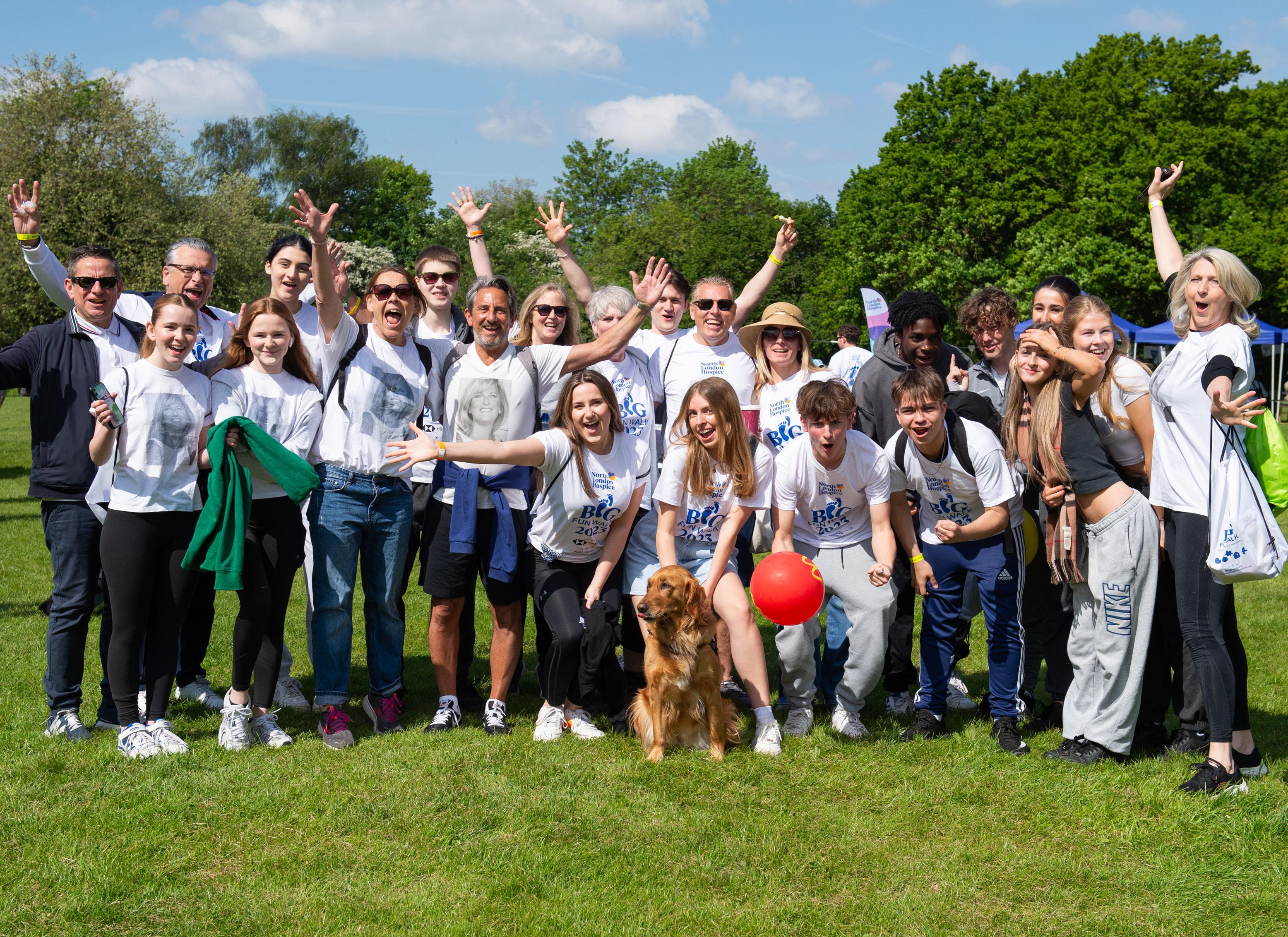
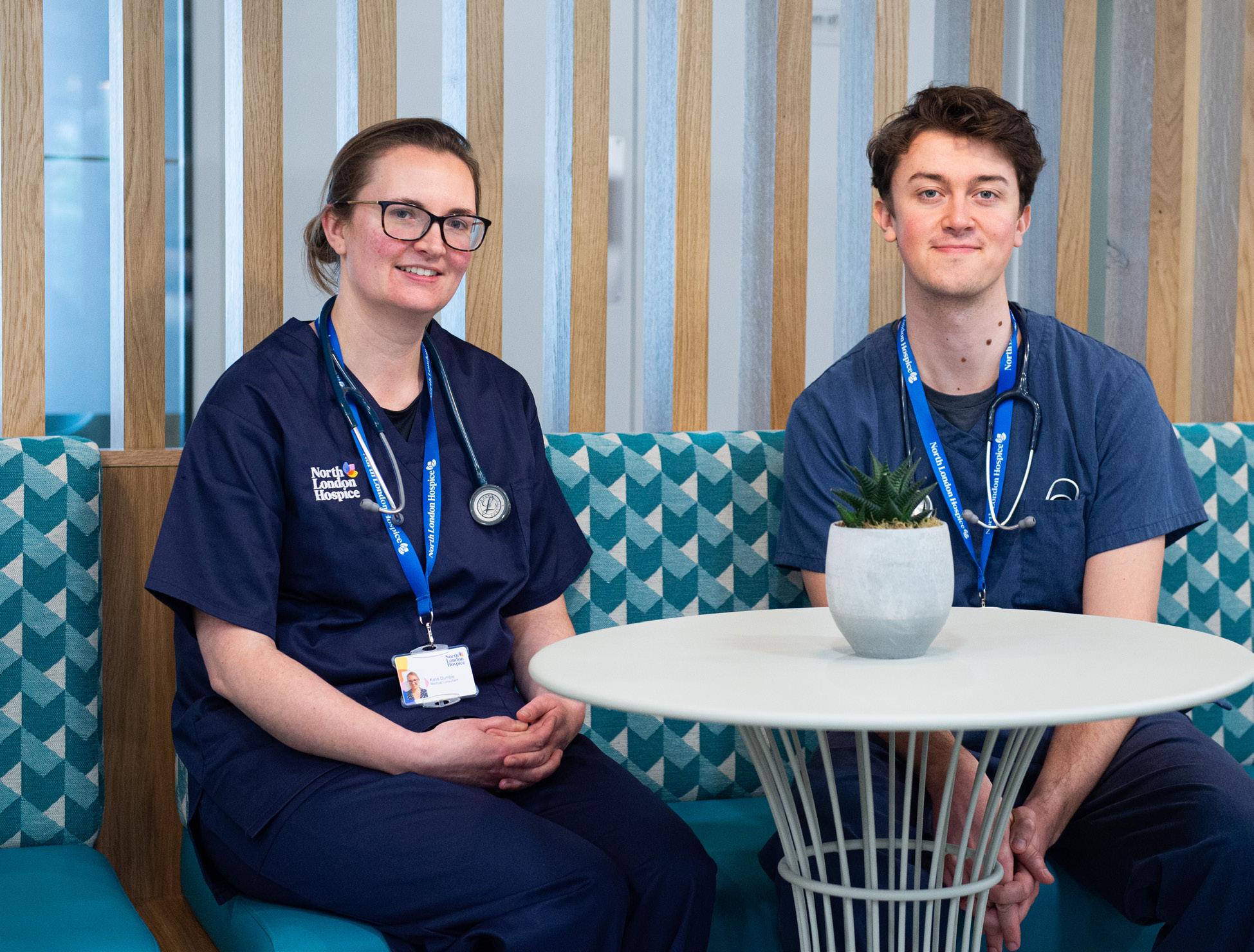
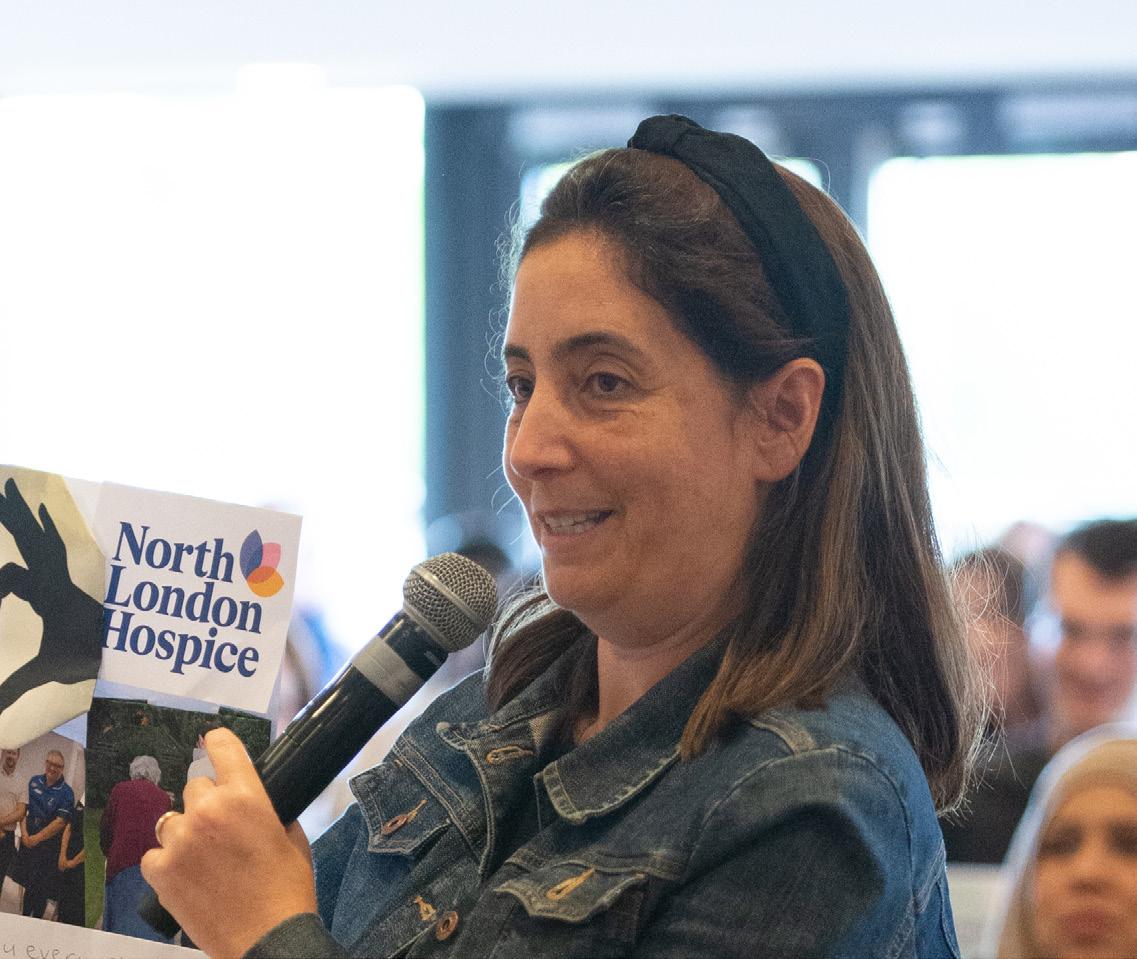
Our Trustees
Contents
Name Committee Membership
Elisabeth Burgess Jones
Chair
Simon Morris MBE Vice Chair
Andrew Harris
Hononary Treasurer and Company Secretary
Member of the Board Development, Finance & External Audit and Fundraising Committee’s
Chair of the Fundraising Committee, Member of the Board Development and Finance & External Audit Committee’s
Chair of the Finance & External Audit Committee and Retail Committee, Member of the Board Development Committee
Anna Bokobza Member of the People & Organisational Development Committee
Tom Easterling
Carol Holmes
Retired June 2023
Chair of the People & Organisational Development Committee, Member of the Board Development and Clinical Governance & Assurance Committee’s
Chair of the Retail Committee, Member of the Board Development Committee
Saurabh Khare Member of the Retail Committee
Simon Males
Member of the Finance & External Audit and Fundraising Committee’s
Dr Mohini Parmar Member of the People & Organisational Development Committee
John Reid
Dr Ujjal Sarkar
Beverley Taylor
Dr Judith Tobin
Jennifer Walters
Retired June 2023
Dr Cate Woodwark
Member of the Finance & External Audit and Retail Committee’s
Member of the Clinical Governance & Assurance Committee
Member of the People & Organisational and Clinical Governance & Assurance Committee’s Freedom to Speak up Guardian
Member of the Clinical Governance & Assurance Committee
Member of the Fundraising Committee
Chair of the Clinical Governance & Assurance Committee, Member of the Board Development Committee
Our Executive Team
Name
Declan Carroll Chief Executive Officer
Dr Sam Edward Medical Director and Consultant
Fran Deane
Left June 2023
Jill Wilde
Appointed June 2023
Director of Clinical Services (until 30th June 2023)
Interim Director of Patient Services (from 19th June 2023)
Anna Cooper Director of Fundraising & Communications
Nadarasa Sooryakumaran
Left April 2023
Kelvin Walker
Appointed March 2023
Commercial and Finance Director (until 30th April 2023)
Interim Director of Finance and Resources (2nd March 2023 to 12th June 2023)
Kelvin Walker Director of Finance and Resources (from 12th June 2023)
Liz Edwards
Left March 2023
June Bridgeman
Appointed March 2023
Suzie Long
Appointed July 2023
Director of People (until 31st March 2023)
Interim Director of People (from 13th March 2023 to 31st August 2023)
Director of People and Culture (from 3rd July 2023)
Registered Office North London Hospice 47 Woodside Avenue, London N12 8TF
Buzzacott LLP
External Auditor
Chartered Accountants and Statutory Auditor 130 Wood Street London EC2V 6DL
Barclays Bank p.l.c.
Bankers
Barnet & Hampstead Business Banking P O Box 12820 London N20 0WE
Newton Investment Management Limited
Investment Managers
The Bank of New York Mellon Centre 160 Queen Victoria Street, London EC4V 4LA
Our Vision
The Best of Life, At the End of Life, for Everyone
North London Hospice cares for patients with a life-limiting illness and supports their families, friends, and carers too. We care for patients in the communities of Barnet, Enfield, and Haringey and in our Inpatient Unit in Finchley. The hospice was established in 1984 as the UK’s first multi-faith hospice and each year we care for over 3,500 patients. We are an independent charity and provide all our care, free of charge.
If you would like this publication to be made available in accessible formats such as alternative languages, large print or audio, please speak to the Communications and Marketing Team on 0800 368 7848 (Freephone) or email CommunicationTeam@northlondonhospice.co.uk
North London Hospice
47 Woodside Avenue, London, N12 8TT
Phone: 0800 368 7848 (Freephone)
Email: nlh@northlondonhospice.co.uk
www.northlondonhospice.org
